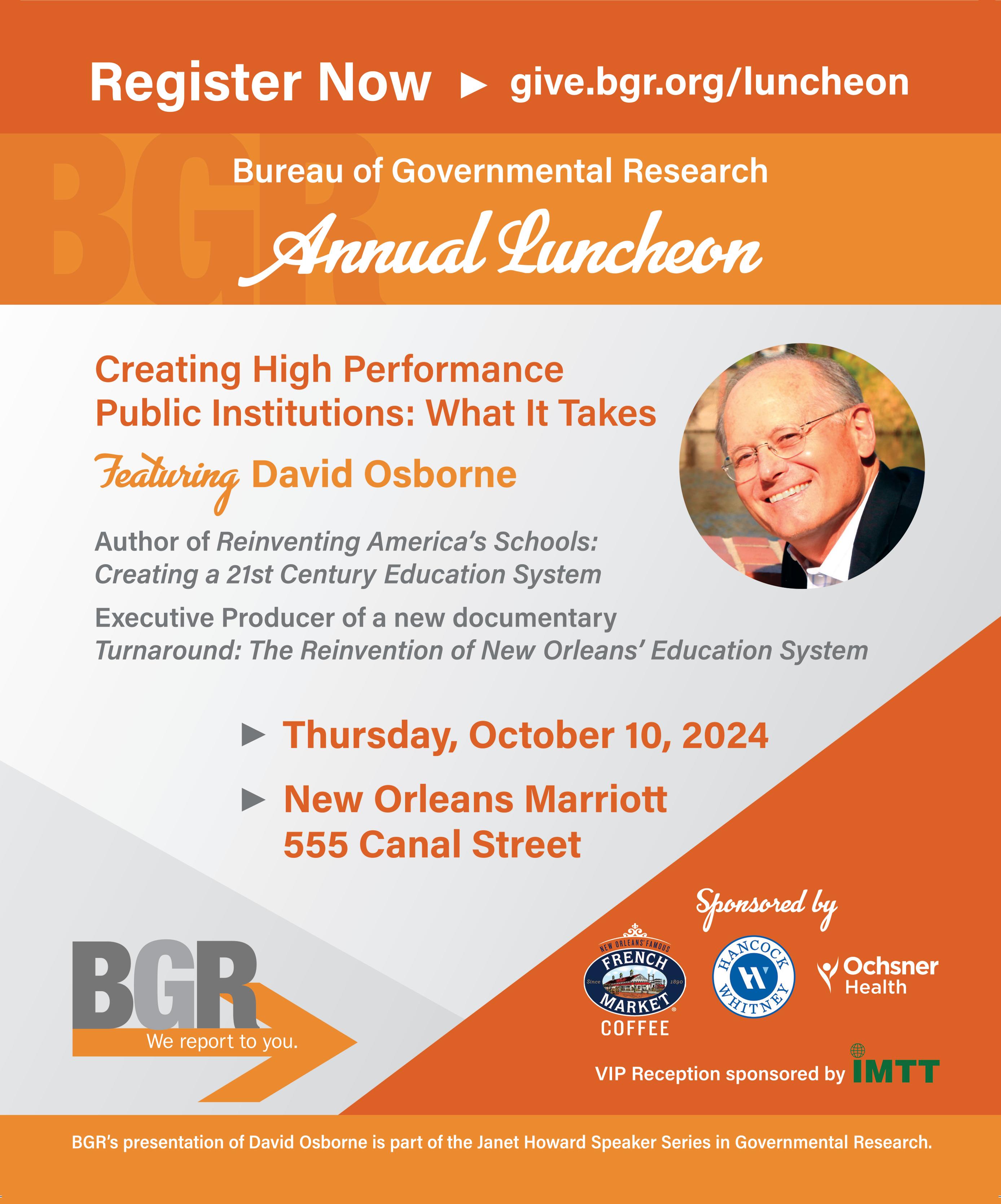
WITH JUST OVER FIVE MONTHS UNTIL SUPER BOWL 59, THE










WITH JUST OVER FIVE MONTHS UNTIL SUPER BOWL 59, THE








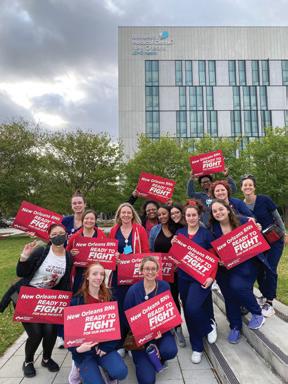
Nurses
Although only five years old, this Marigny garden supply
Mark Romig, chief marketing officer/senior vice president of New Orleans & Company; honorary consul for the Kingdom of
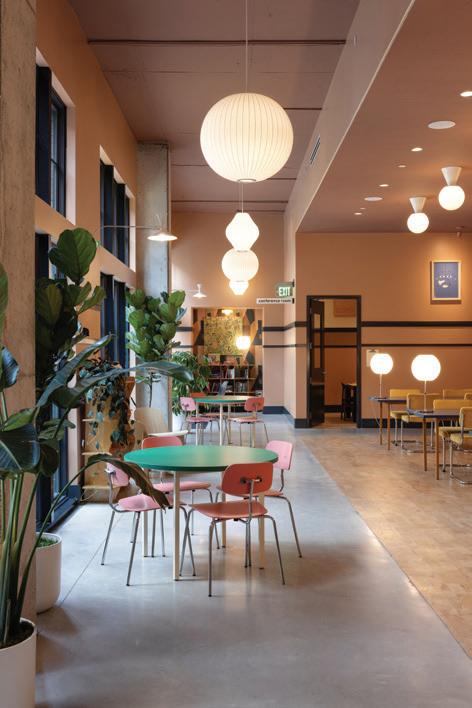
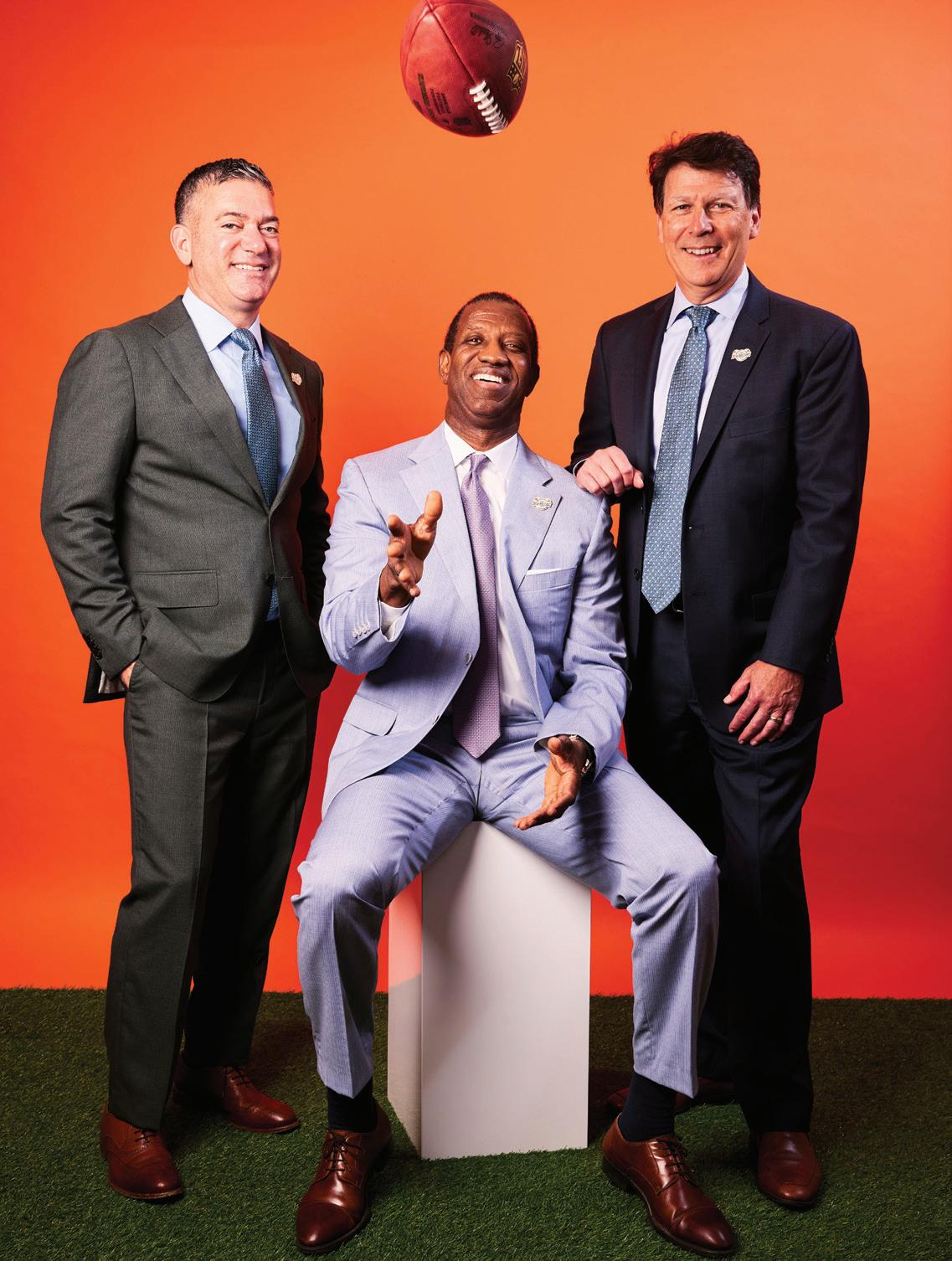
After more than three decades serving as home to the Louisiana Children’s Museum, 420 Julia Street is now home to a different kind of social gathering space.
Fresh off a half-billiondollar renovation, Caesars Superdome is ready to kick off the season... Oh yeah, and play host to the most-watched televised event in America
With just over five months until Super Bowl 59, the New Orleans Super Bowl Host Committee is charging forward, spurred by a message it wants the world to hear



At the Olympics this year, we watched as approximately 10,500 athletes from around the world had their moment — a moment they’ve been preparing for, struggling toward and anticipating in most cases for most of their lives. It’s crazy to think about how all the buildup, all the years and years of constant training, all the sweat and tears and battles and injuries all came down to just minutes, or even seconds, for all the world to see.
In this, our Downtown issue, there was no question what we would talk about. The Olympics of football, the biggest television event of the year, is coming here on Feb., 9, 2025, and the stakes are high. Six years in the planning, we now have just months to go, and more than 1,000 people are working nonstop toward the same goal — ensuring that when the eyes of the world are upon New Orleans they see a city with both a compelling past and a burgeoning future that’s like no other place on earth.
In this issue, you’ll see how the stage is being set — not only with the millions in Superdome renovations, but with the repairs and upgrades going on throughout the city. You’ll meet a few of the leaders behind those efforts, and hopefully you’ll get a sense of the excitement that’s brewing. Not only our Downtown, but our city,
region and state, are going to feel the effects of this little game of pigskin for years to come. And speaking of celebrations! Stay tuned! Next month’s issue is going to be a big one. Biz New Orleans Magazine is celebrating a very special birthday, and it’s also our annual real estate issue!
Thanks for reading,
Publisher Todd Matherne
EDITORIAL
Editor Kimberley Singletary
Art Director Sarah E.G. Majeste
Digital Media Editor Kelly Massicot
Associate News Editor Veronika Lee Claghorn
Perspective Writer Drew Hawkins
Contributors Davon Barbour, Ashley McLellan, Misty Milioto, Chris Price, Frank Rabalais, Poppy Tooker, Keith Twitchell
ADVERTISING
Senior Account Executive Meghan Schmitt (504) 830-7246 Meghan@BizNewOrleans.com
Account Executive Abby Palopoli (504) 830-7208 Abby@BizNewOrleans.com
PRODUCTION
Digital Director Rosa Balaguer Arostegui
Production Designer Ashley Pemberton
Production Designer Czarlyn Ria Trinidad
MARKETING
Marketing Manager Greer Stewart
Sponsored Content Coordinator
Jeremy Marshall
Visual Media Producer Mallary Wolfe
CIRCULATION
Distribution John Holzer
ADMINISTRATION
Office Managers Emily Ruiz
VP of Sales and Marketing Kate Henry
Chief Executive Officer Todd Matherne
For subscriptions, call (504) 830-7231

Editor Kimberley@BizNewOrleans.com



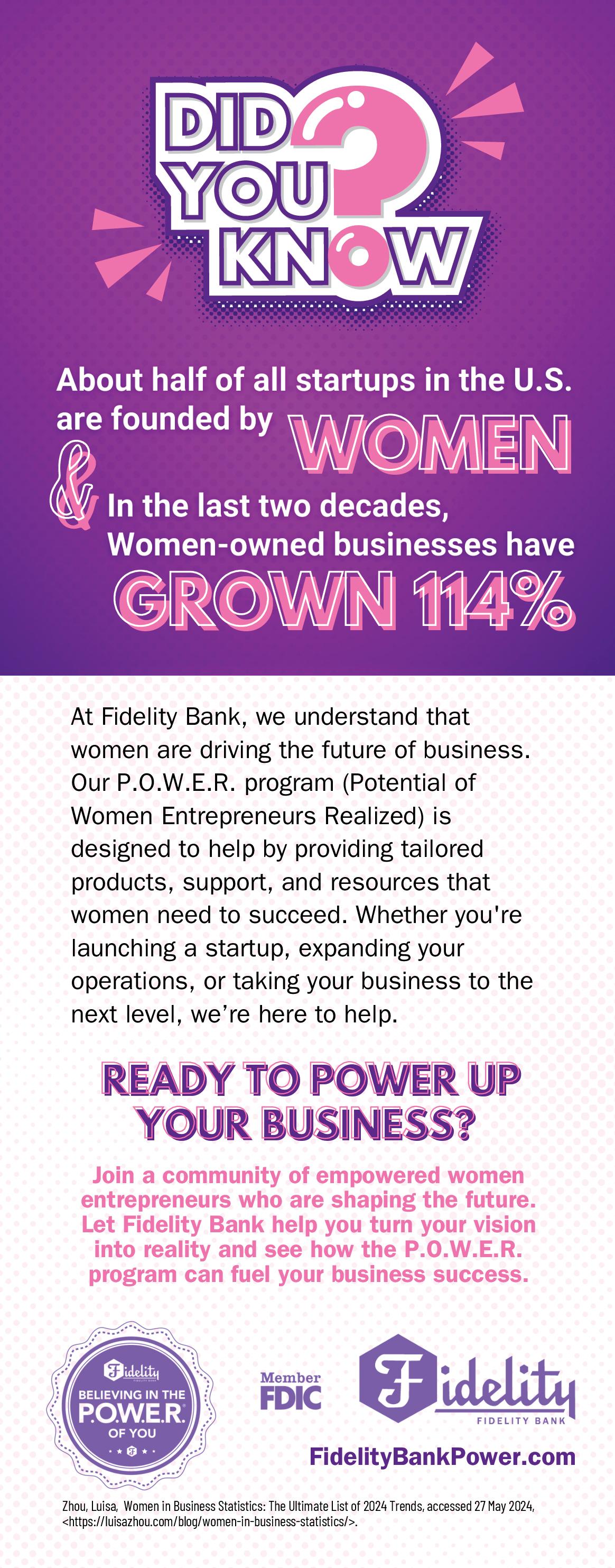


VP of Sales and Marketing (504) 830-7216 kate@bizneworleans.com
Recently, I had the opportunity to visit with Sonny Lee and get an update on the work Son of a Saint is doing throughout our community.
Sonny’s presentation was incredibly eye opening and meeting his team was inspirational. He has a unique way of making you feel welcome while allowing you to be open and engage with his organization. You feel part of the team immediately, and he appeals to your heart so together you can find ways to become a part of the solution.
If you would like to know more, visit sonofasaint.org.
Speaking of people making a difference, at a recent New Orleans Chamber board meeting we received a presentation from Nathaniel Fields, who is heading up the homeless initiative for the city under Councilmember Leslie Harris’ office. He gave an update on the city services and processes that are helping these members of our community get help and off the streets. They have lined up great supporters to help this population in New Orleans. Home for Good is the support organization and has partnered with New Orleans & Company, New Orleans Convention Center, United Way of Southeast Louisiana, Greater New Orleans
Foundation and many more great organizations. If you would like to know more, visit homeforgoodneworleans.org.
Finally, as we move past Labor Day and prepare for the fourth quarter, our team is also planning for a great 2025. The New Orleans region will be in the national spotlight and on the world stage as we host the Super Bowl February 9, 2025, and Jefferson Parish turns 200 on February 11. It’s going to be one incredible week. This is an exciting time for our region, and our editorial team is looking forward to telling more award-winning stories.

Senior Account Executive (504) 830-7246 meghan@bizneworleans.com


Account
(504) 830-7208 abby@bizneworleans.com

From traditional Sazaracs to Louie Louie Pimms Cups, today’s Louisiana’s drink horizons are shifting and expanding in exciting new ways
16
ENTREPRENEUR
8 tips to make sure you hire with care
Can a new offense return the Saints to their winning ways or should fans expect more of the same?
From traditional Sazaracs to Louie Louie Pimms Cups, today’s Louisiana’s drink horizons are shifting and expanding in exciting new ways
BY POPPY TOOKER
When 2018’s Federal Farm Bill repealed America’s 82-year hemp prohibition, Louisiana’s Legislature rapidly opened the door for a burgeoning new industry in the state. Enacting state law governing cultivation and production, by 2019 hemp grew to represent more than $33 million in annual state commerce.
Many different businesses share in the industry’s profits. From the farmer to the extractor and manufacturer, the wealth extends to retailers, bars and restaurants as budding entrepreneurs create products utilizing cannabinoids derived from hemp.
As Paige Melancon exited the oil and gas business in 2019, he saw significant possibilities in hemp extraction, comparable to Louisiana’s well-established local sugar mill industry.
POPPY TOOKER has spent her life devoted to the cultural essence that food brings to Louisiana, a topic she explores weekly on her NPR-affiliated radio show, Louisiana Eats! From farmers markets to the homes and restaurants where our culinary traditions are revered and renewed, Poppy lends the voice of an insider to interested readers everywhere.
After flying across the U.S. to study extraction processes in other states, Melancon built a 10,000-square-foot building on farmland in St. Landry Parish near Opelousas and Louisiana Hemp Extractors (LHE) was born.
Through cryo-ethanol extraction, LHE extracts cannabinoids “without sacrificing any healing properties.” This was vital to Melancon who said he has seen hemp’s incredible natural healthcare solutions in action.
“While the FDA prohibits selling any hemp-related products as a treatment or cure, THC, CBD and CBG are revolutionizing self-directed natural health,” said Melancon. “We’ve seen people get off prescription meds by getting better sleep, having lower blood pressure and even getting off alcohol.”
Louisiana Hemp Extractors began by selling bulk oil and servicing other fledgling businesses with custom product formulation, licensing, bottling and packaging. Initially, LHE manufactured a limited number of tinctures and lotions for the retail market, but in 2022, when new Louisiana legislation allowed production of edibles and seltzers, Melancon began crafting a broad range of gummies and drinks available wholesale and direct to the public under the BakPak label.
THC- and CBD-infused edibles typically have a delayed effect. Cannabinoids enter the bloodstream through the small intestine’s walls after first travelling through the stomach and digestive system. New seltzers, however, have dramatically altered the effect’s timeline. Through a nano emulsion process, water soluble cannabinoids are quickly broken down by liver enzymes and absorbed much more efficiently.
On the seltzer front, local brand, self-described “Good Time” seltzer Louie Louie claims an “alcohol-free, balanced high that’s sessionable.” Each can incorporates 5% CBD and 5% THC. “You feel the effects in fifteen minutes or so, allowing you to decide if you want more,”

Louie Louie co-founder, Eric Becker said. “CBD relaxes your body while THC has a more mental or emotional effect. The results differ, but basically Louie Louie gives a balanced mellow feeling – not tired or over enthused.”
After just over a year on the market, Louie Louie partners, Eric Becker, Ken Jackson and Marie LaFrance are riding high. While Becker, a former attorney, handles business legalities, Jackson specializes in product development with LaFrance overseeing company marketing. The brand’s name alludes to cultural touchstones, including the 1963 hit “Louie Louie,” made famous by The Kingsmen. (Derided at the time as obscene, the song even prompted an FBI investigation that could be seen as similar to 20th century suspicions surrounding hemp). Louie Louie also gives a nod to native son Louis Armstrong’s avid affection for cannabis.
“But foremost, it’s a Louis-iana company,” Becker exclaimed.
Louie Louie’s three initial flavors created a stir nationally, receiving “Best Of” awards from industry leaders BevNet and High Spirits in 2023. While developing those original taste profiles, Jackson highlighted Louisiana satsumas with a hint of thyme and cinnamon. He designed the blackberry lemon version with notes of anise reminiscent of a favorite champagne cocktail. During development of a ginger cucumber variety, Jackson was constantly reminded of the classic Pimm’s Cup cocktail.
The taste parallel immediately resonated with Nathan Frusti, Napoleon House’s beverage director. Frusti urged the Ralph Brennan Restaurant Group to use Louie Louie in an alcohol-free Pimm’s Cup at the venerable establishment.
Catch Poppy Tooker on her radio show, “Louisiana Eats!” Saturdays at 3 p.m. and Mondays at 8 p.m. on WWNO 89.9 FM.
“Sales have soared as patrons appreciate the availability of something besides alcohol,” Frusti said. “It’s also a great alternative for the restaurant industry’s traditional after-work shift drink.” T

Can a new offense return New Orleans to its winning ways or should fans expect more of the same?
BY CHRIS PRICE
There is always excitement in the air in New Orleans as the Saints embark on a new season, but the environment is not as electric as it once was.
The Black & Gold won the NFC South four seasons in a row from 2017-2020, posting a 49-15 mark and averaging 12.25 wins and 3.75 losses per season. Of course, there are some major differences between the two eras, namely the departure of head coach Sean Payton and quarterback Drew Brees, arguably the best people to hold those positions in franchise history.
In the three seasons since, 2021-2023, under head coach Dennis Allen, the Saints are 25-26, averaged 8.3 wins compared to 8.7 losses, and missed the playoffs each year. Looking forward to the 2024 season, it seems like Saints fans will get more of what they’ve been given.
I don’t gamble; however, I’m intrigued by those who do put their money where their mouths are. While the Buccaneers (9-8) won their third straight NFC South title last year, the Saints (9-8) finished second, Falcons (7-10) third, and Panthers (2-15) last. Professional gamblers are expecting a shakeup at the top of the division. According to Caesars Sportsbook, Atlanta is the favorite to win the division with a prediction of 9.5 wins this
season. Tampa follows with 8.5, the Saints are expected to win 7.5, and the Panthers see improvement at 5.5 wins this season.
Many expect the 2024 season to be a crossroads for the Saints. For years, New Orleans has flirted with salary cap disaster. Fans have been told that the team was mortgaging its future to win during the Payton years. Now, it seems the team is facing that cold reality.
Even though the Saints have the fifth easiest schedule in the league, according to Sharp Football Analysis, sports books expect to see the team regress — mainly due to aging stars, an average roster, quarterback play, and numerous questions on the offensive line. However, there is hope that QB Derek Carr, who had a good second half of the 2023 season, can continue his positive momentum with the addition of offensive coordinator Klint Kubiak.
While running back Alvin Kamara has been able to elude NFL defenders, can he escape the grasp of Father Time? That same question could be asked of several players on offense and defense, including linebacker Demario Davis, defensive end Cam Jordan, safety Tyrann Mathieu, and Swiss Army Knife Taysom Hill. The team has solid wide receivers in Chris Olave and Rashid Shaheed, but neither are considered top players at their positions.
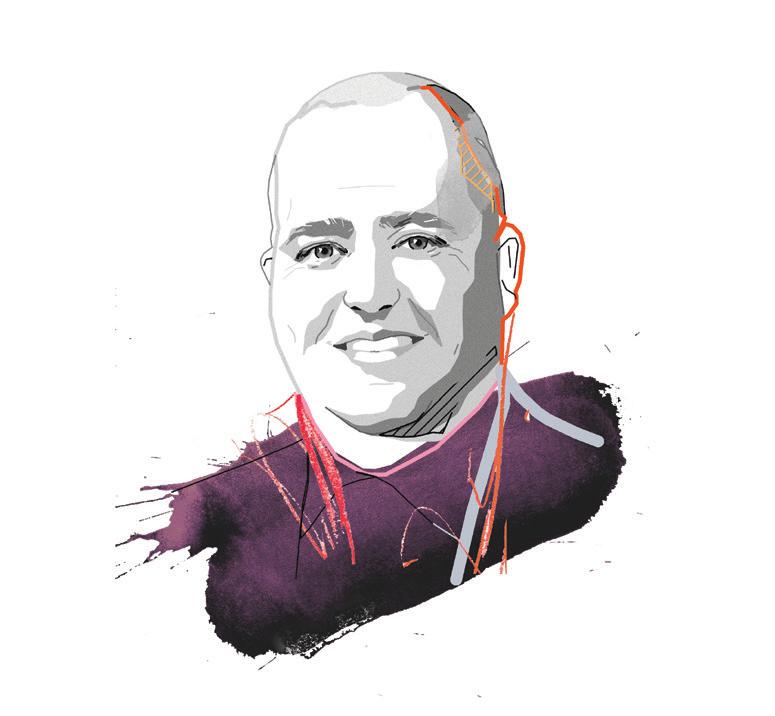
The biggest question marks for this team are on the offensive line. Always a team strength under Payton, the formidable front line appears to be less like a brick wall and more like a picket fence. If the O Line doesn’t come together as a cohesive unit, it will be a long season for the Saints and their fans.
Under Allen, a defensive-minded coach, it’s not surprising that the defense has been the most solid unit of the team. The Saints’ D has been among the Top 10 in the NFL and has kept the team competitive in recent years. Expect that trend to continue. If — and this is a big if — defensive end Chase Young, the second overall pick of the 2020 NFL Draft who the team signed to a one-year, $13 million deal, proves to be healthy and makes an impact, he could be an amazing addition to the defensive line. The unit’s secondary is a strength, bolstered by the addition of second-round pick Kool-Aid McKinstry, an All-American from Alabama.
The hardest part of covering a beloved sports team is being objective and resisting becoming a “homer” who only promotes positivity. The truth is, I think 2024 will be a transitional year for the Saints. There is hope that the team can break out of the mediocrity it has shown under Allen. If it does, great. Laissez les bons temps rouler! If it doesn’t, the time may be right for several significant changes to the team’s coaching staff, roster, and, most importantly, its salary cap situation.
As it is now, I see the Saints as a .500 team. With a 17-game schedule, that likely means a 9-8 or 8-9 season. Good enough to run with the pack, but not enough to lead it. In New Orleans, however, with the Saints, there is always hope. No one foresaw the team’s successes in 2006 or 2009. This may be one of those seasons. However, if past is prologue, Saints fans are more than likely going to have to lean on their faith as their team endures the 2024 season.T

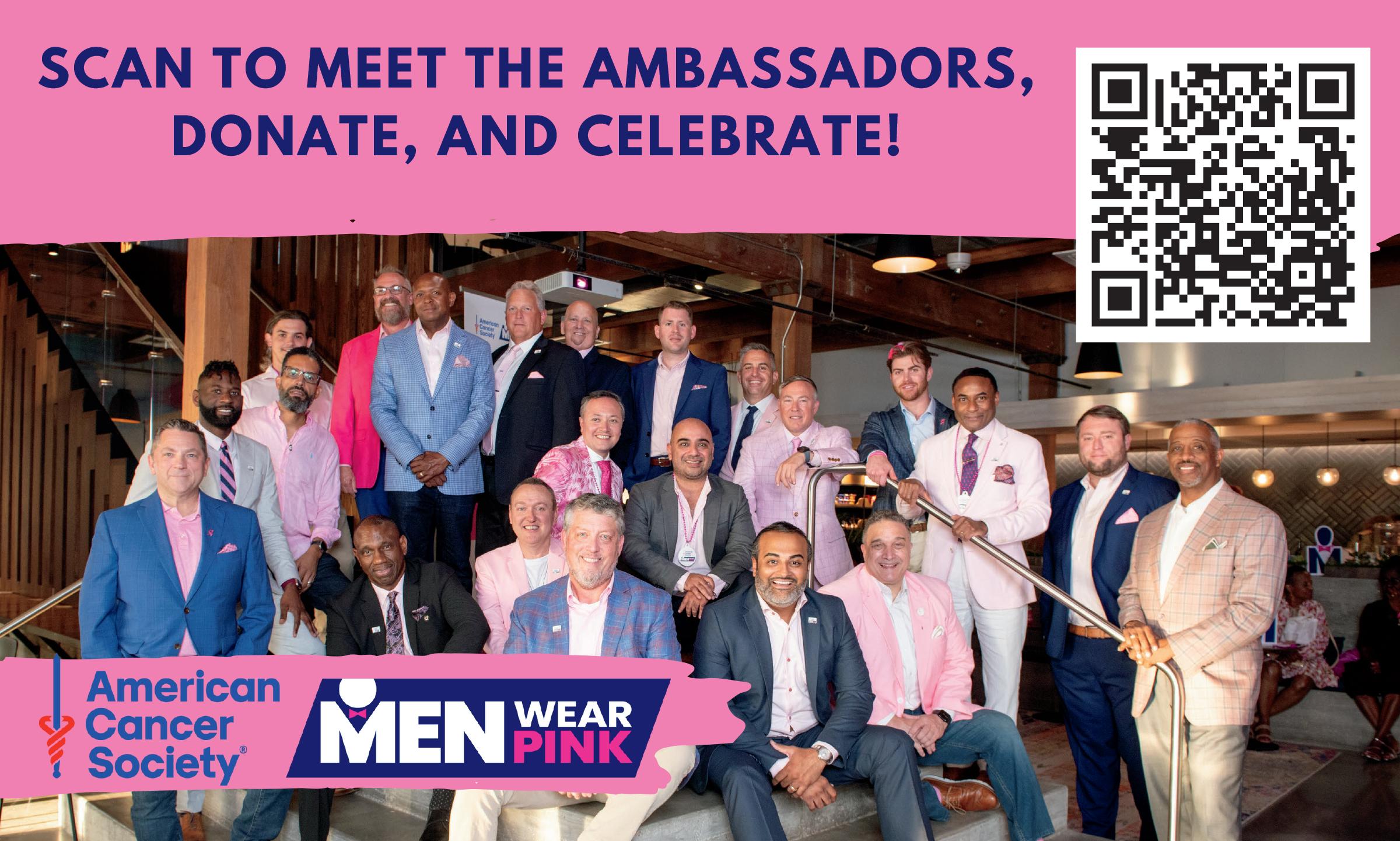
BY KEITH TWITCHELL
Few decisions in the life of an entrepreneur carry more weight than when to begin hiring staff and how to make the right hires.
Success starts with a thorough, honest analysis of your business’s circumstances, and diligent preparation.
GET REAL. “You have to have a clear idea of what your capacity is, your bandwidth to manage people,” said Jennifer Jeansonne, owner of JAJ Consults, a small business recruiting firm. “You should also consider how much money are they going to bring in versus how much you are going to pay them.”
KEITH TWITCHELL spent 16 years running his own business before serving as president of the Committee for a Better New Orleans from 2004 through 2020. He has observed, supported and participated in entrepreneurial ventures at the street, neighborhood, nonprofit, micro- and macro-business levels.
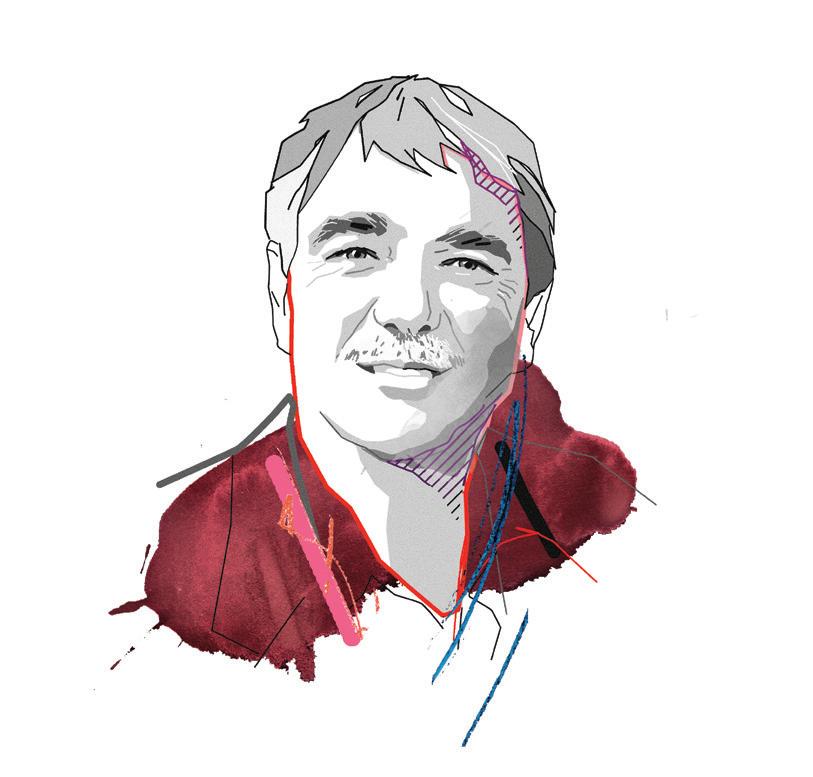
EXPLORE THE OPTIONS. Rather than dive right in with full-time hires, Jeansonne suggested looking at a phased-in approach, beginning with parttime employees and/or 1099 contract employees.
“Today’s work environment gives employers more flexibility,” she noted. “With contract or part-time workers, you can check them out. Do they fit with your team, do you like their work?”
Not committing right away to a full-time employee also reduces risk if the business fails to grow as expected. However, if going the contract worker route, owners must make sure they have a clear understanding of the strict regulations governing these relationships.
GO SLOW. Growing staff slowly worked well for Josh Owen, co-founder of Comfystone Films, a video marketing agency.
“We always had the idea of hiring, it was just a question of when we were capable of hiring,” he recalled. “Hiring someone part-time helped us learn a lot of what we needed to know going forward.”
Owen also experimented with hiring.
“We had friends come on board in different roles,” he explained. “These were people who we knew bought into our vision, and it helped us figure out what we should be looking for.”
BE HONEST WITH THEM, AND YOURSELF. “Look at what job tasks you need that person to do, how you want them to contribute and what skill sets you need,” advised Jeansonne, who emphasized that looking for skills and attributes is more important than simply reviewing a candidate’s experience. Creating an effective job description should begin with a realistic description of the job, and your expectations for the person who fills it. List some key attributes, such as being outgoing, being a self-starter, etc. Also vital are including where you expect the person to work and setting a realistic pay range.
“Do some research about the market rate for the position,” Jeansonne recommended. “Being
honest about this up front gets you off on the right foot with new hires.”
BE FLEXIBLE. After creating the job description, Jeansonne encouraged employers to “identify the need, the nice and the deal-breakers” when looking at a job description. Could someone be a great fit if they don’t meet every item on your wish list?
SPREAD THE WORD. Circulating the description widely enough to attract a good candidate pool is vital. There are multiple free job boards available in Southeast Louisiana. Networking among friends and colleagues for candidates is also a good approach. Use any marketing and/ or social media resources to help. Depending on the position, paid job search sites can also be an option.
INTERVIEW LIKE A PRO. “Create an interview structure, with questions you will ask each candidate,” Jeansonne advised. “Example questions are really useful, especially when you connect them to the job tasks.”
A good interview should be a dialogue, since a smart candidate will also be interviewing you. And a good telltale is how much the candidate knows about your firm, indicating that s/he prepared ahead of time.
PREPARE TO ONBOARD. “Make sure your business is ready; you can never be too prepared for this person coming in,” observed Owen. “You need processes and procedures they can understand. You want to make sure that person can operate without you around all the time.”
Indeed, hiring and onboarding are simply the beginning of continuous employee management.
“You should never stop trying to engage your employees,” advised Jeansonne, “making sure they feel supported and wanted in your organization.” T

A look at three different programs aimed at addressing financial inequity in New Orleans
BY DREW HAWKINS
Financial literacy isn’t just a buzzword — it’s a crucial stepping stone toward economic independence and stability, especially for women of color and area youth.
The fight for financial equity in New Orleans has birthed several initiatives aimed at equipping women and young people with the financial acumen they need to thrive.
PLAYING TO WIN Chris Surprenant, professor and director of the Urban Entrepreneurship & Policy Institute at the University of New Orleans, recognized the need for financial literacy in youth a few years ago, so he helped launch a financial education program for high school students.
“This is a class about being smart with money and understanding the value of money, how to earn it, how to keep it, how to grow it and how to protect it,” he explained.
Over the course of a semester, students started a real business from scratch. First, they spent a few weeks looking for opportunities and identifying their own skills to come up with
DREW HAWKINS is a writer and journalist in New Orleans. He’s the health equity reporter in the Gulf States Newsroom, a collaboration among public radio stations in Louisiana (WWNO and WRKF), Alabama (WBHM) and Mississippi (MPB-Mississippi Public Broadcasting) and NPR. He’s also the producer and host of Micro, a LitHub podcast for short but powerful writing.
a business idea. Then they went through the process of starting and operating that business, learning everything from budgeting to reading income statements, understanding loans and investing.
As the program was getting started, it caught the attention of former New Orleans Saints wide receiver Marques Colston and fullback Jed Collins.
Colston had previously taught a class on leadership and entrepreneurship at UNO. Surprenant was having lunch with Colston when they came up with this idea.
“We both thought it was really important for these kids to come out of high school with relevant knowledge and skills, and we thought we had the knowledge and resources to help make that happen,” Surprenant said.
UNO teamed up with Colston’s Dollars to Dreams program and Collins’ Money Vehicle curriculum to teach financial literacy to high school students.
“A lot of my work with students is anchored in making entrepreneurship a more accessible and viable option. This program takes a similar approach to personal finance,” Colston said. “It aims to provide an educational experience that aligns a tailored curriculum with resources to help students gain a better understanding of their current financial realities.”
Colston said the program’s goal is to provide a financial education experience that students can apply immediately.
“Finance is a core factor in most of the decisions we make,” Colston said. “But many young people today are making important personal and professional decisions that have financial ramifications they might not understand until it’s too late.”
TAKING FLYTE Financial literacy is more than just understanding how to balance a checkbook or invest in stocks — it’s about empowerment and equity. Flyte, a New Orleans-based nonprofit, takes a holistic approach. Founded by Alexander Bigbie, Flyte focuses on empowering Black women-owned businesses and addressing systemic financial inequities.
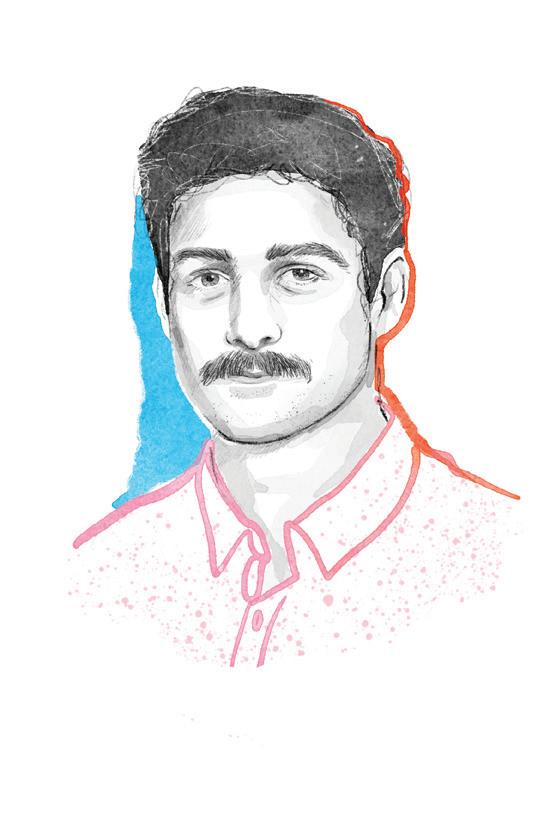
“Our program runs 12 months, starting in June each year, and currently serves 100 small-business owners across Louisiana, mostly concentrated around New Orleans and Southeastern Parishes,” said Bigbie. “We focus on three main areas: mentorship, education and access to resources.”
Flyte’s program is largely virtual, ensuring accessibility for business owners who juggle jobs and family responsibilities. With a curriculum covering topics like credit building, budgeting and financial planning, Flyte also emphasizes “the emotions of finance,” in partnership with The Brightside Collective, a local therapy group.
“Black women have the highest rate of business creation but also the highest rate of business failure,” said Bigbie. “We aim to break those barriers down and ensure their finances and businesses can thrive in the long term.”
Similarly, the Junior League of New Orleans (JLNO) has been instrumental in promoting financial literacy for women since launching their program in 2017. Tara Waldron, president of JLNO, highlighted the program’s objectives: “We developed a curriculum which focuses on five key financial topics: banking, borrowing, budgeting, saving and investing.”
JLNO’s sessions are open to the public, targeting a diverse group of women. The initiative was inspired by the gender gap in financial literacy and the significant impact that financial education can have on women’s lives.
“Studies show that when women have money and invest, they tend to be better investors and money managers than men,” Waldron said. “We just need to give them the information to do so.”
JLNO partners with high schools, Girl Scouts, and banks like Capital One and Hancock Whitney to extend their reach. They ensure accessibility by offering sessions free of charge, welcoming collaborations with other nonprofits to benefit more women.
“Our sessions are free of charge,” said Waldron, “and open to all women interested in learning more about managing their finances.” T



HEALTHCARE
DID YOU KNOW? According to a national workplace survey of nurses completed in 2022 by the American Nurses Foundation, on a weekly basis 31% of nurses are required to work beyond their scheduled shift to provide adequate care to patients.
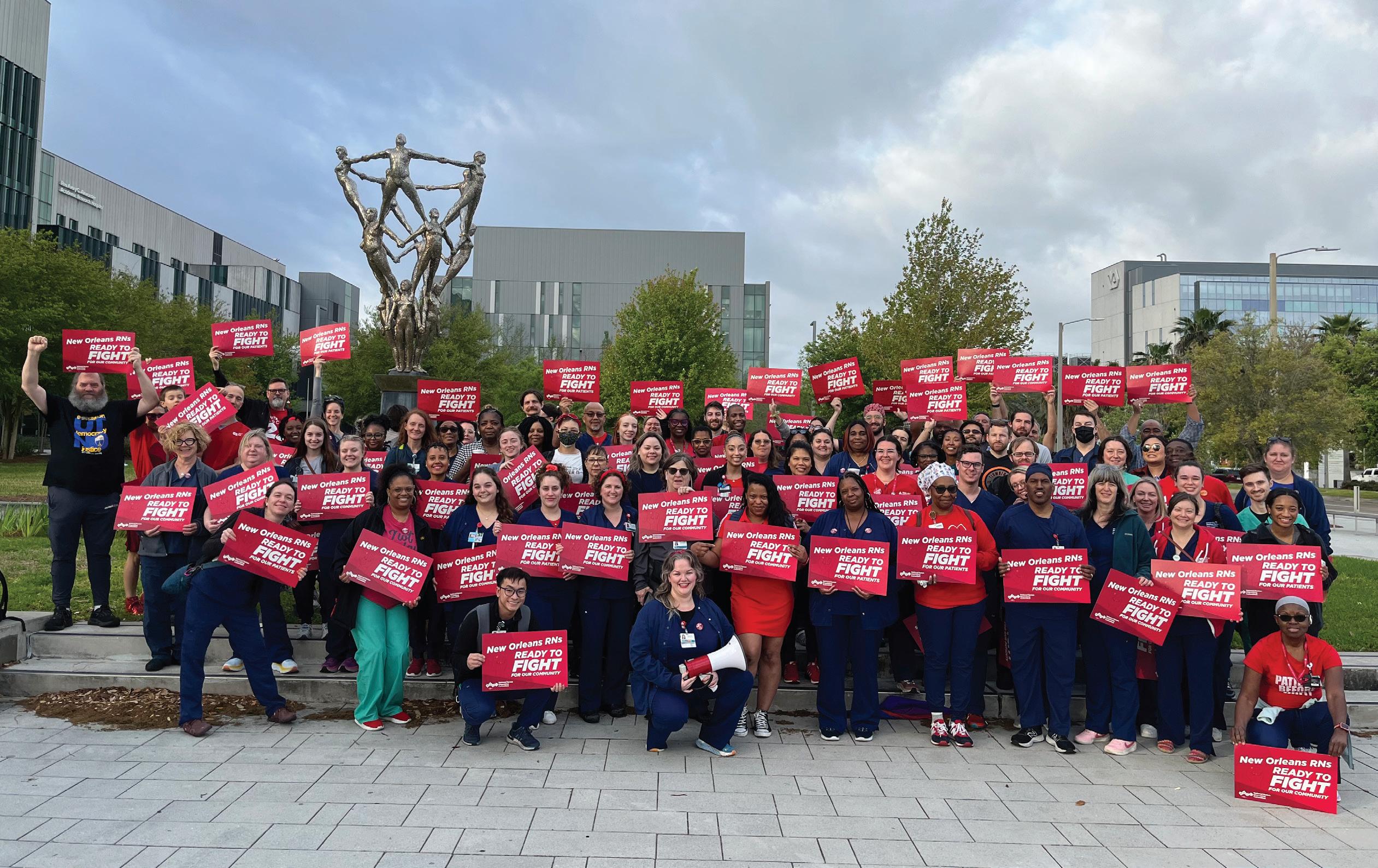
Nurses demand better safety measures amid rising workplace violence
BY DREW HAWKINS
There’s a glass barrier at the nurses’ station in the behavioral health unit at University Medical Center (UMC). It’s designed to keep nurses safe from patients who may be experiencing a mental health crisis — or may become upset if they aren’t given the medication they want.
“We’ve had patients jump over and get through that glass and want to attack you,” said Keisha Montes, a behavioral health nurse at UMC. Montes said she’s been spit on and had personal threats made against her life.
The healthcare industry sees more workplace violence than any other industry, according to the Occupational Safety and Health Administration (OSHA). Nurses are nearly five times more likely to be injured by workplace violence than other workers in the U.S. — and most of it caused by patients.
As healthcare workers are experiencing a surge in workplace violence rates nationally, Montes and about 80% of UMC’s nursing staff have organized and are calling for better protections. Last December, they voted to form the first and only private sector nurses’ union in Louisiana.
Nurses also have basic security concerns about things like weapons in the facility. The threats are real, Montes said, noting that in March, a patient came into the hospital armed with knives and a gun. She said the staff was alerted to the issue after a family member called to warn them.
Montes noted that at UMC, behavioral health patients often must share a room.
“So just imagine if you’re in a room with someone who’s paranoid,” Montes said. “Or another who may be homicidal…It’s just not safe that these patients have to share rooms because they get upset with us and it becomes our problem.”
Lauren Waddell, a nurse practitioner for outpatient neurosurgery at UMC, echoed Montes’ concerns and experiences. She said that when the hospital is short-staffed, even everyday situations can escalate into disputes or violence because nurses may be spread too thin.
“I’ve personally been threatened to be followed to my car if I did not prescribe a certain narcotic pain medication... It’s not OK for nurses to feel unsafe at work,” Waddell said.
Waddell said that patients are safe when nurses are safe because it allows them to focus on patient care.
“We need more nurses, and we need staff dedicated to keeping our hospital safe,” Waddell said.
UMC is the only Level 1 trauma center in the city, meaning it can provide the highest level of care for a patient with a major traumatic injury — things like serious car accidents or gunshots. It’s also the only verified Burn Center in the Gulf Coast, a crisis center for behavioral health, and the healthcare provider for the incarcerated — in addition to being a safety net hospital, providing care for everyone, including uninsured patients.
The nurses at UMC are members of National Nurses Organizing Committee/National Nurses United (NNOC/NNU), a nurses’ union. They’ve submitted a variety of proposals to hospital
“ ” I’ve personally been threatened to be followed to my car if I did not prescribe a certain narcotic pain medication... It’s not OK for nurses to feel unsafe at work.
Lauren Waddell, nurse practitioner for outpatient neurosurgery at UMC
Nickens noted that the hospital recently launched a new initiative called “UMC Safe,” which includes improvements like the installation of security cameras, panic buttons, and increased security patrols, especially in highrisk areas like the emergency department.
The UMC Safe initiative also includes regular training on infection control, de-escalation techniques, proper handling of equipment to prevent injuries, and establishing committees and feedback mechanisms to continuously assess and improve safety protocols.
Part of the effort, Nickens said, includes an emphasis on retaining current staff attracting new staff. That includes creating pipeline programs and partnerships with local universities and institutions to offer pathways into healthcare careers, as well as providing mental health support with UMC’s Be Well Center, a resource center dedicated to the mental and physical well-being of staff.
“For us, it is important that we a create safe and supportive workplace environment and a culture of wellness,” Nickens said.
Healthcare workers have long faced higher rates of violence. But that was made clearer during the pandemic, when the incidence of verbal and physical threats toward healthcare workers by patients and their families rose significantly.
“As healthcare workers, we see patients and their families when they are most physically, mentally and emotionally vulnerable,” said Dr. Nigel Girgrah, chief wellness officer for Ochsner Health, which experienced a 20% increase in workplace violence in 2022. “This can make individuals feel desperate and increase the likelihood of violent outbursts. I think that heightened sense of desperation accelerated during the pandemic.”
administrators that focus on several concerns including installation of metal detectors, education on proper de-escalation techniques, and protection for healthcare workers who are victims of workplace violence.
“These are basic, common-sense measures to make our hospital safer for everyone because nurses know an ounce of prevention is worth a pound of cure,” Waddell said.
John R. Nickens IV, UMC’s CEO and LCMC Health’s president of hospital services, said the hospital faces complex challenges daily, and UMC’s location in the heart of the city presents unique challenges because “crime and violence remain more prevalent in urban areas.”
Girgrah said the “permissive culture” that has existed historically in medicine that “writes off” incidents of disruptive behavior and violence as just a part of the territory that comes with the profession needs to change.
Like UMC, Ochsner is focusing on new initiatives, including an Office of Professional Well-Being.
For now, the nurses at UMC say they’re optimistic about the dialogue they’ve opened with hospital administrators, and they plan to continue to voice their concerns as a union.
“We’re fighting to get better safety in writing in our contract,” said Waddell. “It’s the only way to legally guarantee the hospital will do what it takes to protect nurses, our patients, and our community.” T
BY VERONIKA LEE CLAGHORN
In early August, Southern Rail Commission announced the reinstatement of the Gulf Coast Amtrak train route between New Orleans and Mobile, Alabama. Representatives from the organization — which aims to promote economic development along rail corridors — stated that passengers could expect the railway relaunch as early as Q1 of 2025.
While platforms are ready in New Orleans at Union Station with four more stops in Mississippi (Bay St. Louis, Gulfport, Biloxi and Pascagoula), the Mobile station still needs to be built.
The schedule and fare details for the new service will be available on Amtrak.com approximately 90 days before it starts, with bookings expected to open around November 9 if the service launches in time for the Super Bowl. Representatives from the Southern Rail Commission invited Biz New Orleans to look at current ticket prices in similar markets as rates are not currently available.
The mileage between New Orleans to Mobile is currently 143.9 miles via I-10, which is comparable to the distance between Philadelphia and Washington, D.C. Fares between these
VERONIKA LEE CLAGHORN is the associate news editor of BizNewOrleans. com. She may be reached via email at Veronika@BizNewOrleans.com.
two cities in the Northeast Corridor range from $11-$68 for coach class seats. Comparatively, business travel expenses per the IRS current mileage rate is 65.5 cents/mile, which means employees traveling by car could expect to expense about $90 for a one-way trip.
Although Amtrak offers a similar, albeit longer service to Houston from New Orleans, train tickets can sometimes cost $400-plus.
Users on New Orleans Reddit expressed skepticism about the New Orleans-to-Mobile route, suggesting the project may fall by the wayside and become too expensive and too inefficient to warrant its use. Criticisms have fallen short, however, in recognizing development of the aerospace industry in the Gulf Coast region since Hurricane Katrina and the discontinuation of the original Amtrak service.
Aerospace engineering is already well-established on the Gulf Coast, with notable players such as NASA Michoud in New Orleans and the Stennis Space Center in Mississippi contributing to the region’s industry presence.
Additionally, Mobile’s Airbus aviation manufacturing facility stands out as a significant hub in the area. The presence of Airbus could be particularly advantageous for residents of the Gulf Coast who might seek hybrid work opportunities. The company’s commitment to local training and apprenticeships could create substantial benefits for Amtrak passengers traveling between New Orleans and Mobile. By enhancing local job prospects and spurring economic growth, Airbus’ investment could improve regional infrastructure and services, including potentially bolstering Amtrak’s facilities and connectivity. Furthermore, competitive pay and robust development opportunities provided by Airbus could foster a more prosperous community, which in turn might increase passenger traffic and elevate the overall vitality of the region.
In addition to its benefits for residents and Amtrak passengers, the presence of Airbus and the growth of the aerospace sector on the Gulf Coast could also enhance connectivity for international travelers. New Orleans’ Louis Armstrong International Airport (MSY) serves as a major gateway
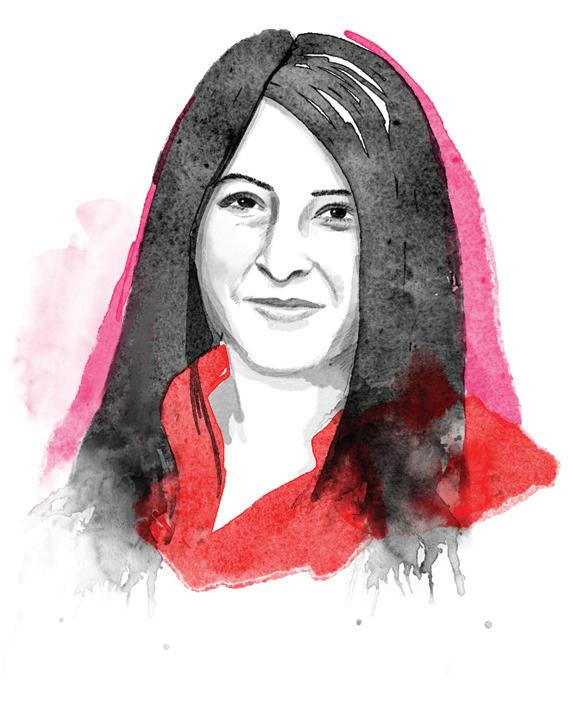
for global visitors, making it a strategic point for accessing Mobile. Improved regional infrastructure and services driven by Airbus’s investments could streamline travel between New Orleans and Mobile, making it easier for international tourists to explore both cities.
Enhanced connectivity would not only boost tourism in Mobile but also foster a stronger regional economy, as increased international traffic could lead to more business and leisure travel, enriching the overall travel experience and promoting economic growth throughout the Gulf Coast.
Amtrak made its largest annual capital investment ever in FY 2023, investing nearly $3 billion into modern trains, enhanced stations and facilities, new tunnels and bridges and other critical infrastructure upgrades. This represents part of a multi-year program of investment that will be the largest capital program in the company’s history.
An inaugural train is planned for the day before regular service begins. The service will feature two trains daily traveling from New Orleans to Mobile and two trains daily from Mobile to New Orleans. Each stop in the four Coast cities will be brief, allowing passengers only a few minutes to board or disembark.
Transportation Planner Colin Ash stated in an email that he would welcome improvements to the Houston-bound train system, as well as more connectivity throughout the Gulf Coast.
“With a streamlined number of routes as compared to the Sunset Limited (like New Orleans, Baton Rouge, Lafayette, Lake Charles, Beaumont, and Houston), a train could do comparable time to driving, be cheaper than a tank of gas, you could work or read or watch movies the whole way, and you’d be right downtown when you got there,” he said.
While Ash doesn’t necessarily see the train systems in the region becoming as efficient as those in Europe, he does feel they could contribute to a stronger skilled workforce. “Brain drain from the metro area is taking away young people to places where this kind of lessstress, more-fun and more efficient travel is available. It’s really a shame.” T



PERSPECTIVE
DAVON BARBOUR is the president and CEO of the Downtown Development District (DDD). He may be reached via email at dbarbour@downtownnola.com.
With a new board and a new economic development strategy, the Downtown Development District is looking to reshape the city’s core
BY DAVON BARBOUR
As president and CEO of the Downtown Development District, I am thrilled to have the privilege of working to implement our exciting vision for the future. With a rejuvenated board and a recently released economic development strategy, Downtown New Orleans has never been more poised for transformative growth.
The heart of our renewed commitment to growth lies in our dynamic new board from diverse industries. The group brings together several board veterans with new commissioners representing a wide range of Downtown industries such as hospitality and corporate business. While the new board represents diverse interests, it is united by a common goal: to drive Downtown New Orleans forward. I look forward to working with our new commissioners to craft policies and programs that reflect the multifaceted nature of Downtown and its many assets.
When it comes to strategies for a prosperous Downtown, my team and I work to implement a comprehensive economic development
strategy marked by collaboration between city and state agencies and with the community.
At its core, our strategy emphasizes that, with utmost priority, enhancements to public safety and quality of life are foundational to building a compelling residential, business and tourism address. Examples of this type of work include our dedicated Public Safety Rangers and investment in enhanced security details who walk the district 24/7. Our commitment to public safety and quality of life can also be seen in the work of our Clean Team — who, this past January, were tasked with maintaining a greater presence on Canal Street and the surrounding “100 Blocks” where we see the most foot traffic.
Beyond the basics, our new economic development strategy is comprehensive and forwardthinking. It spans six focus areas and includes the work and initiatives of all DDD staff. The following focus areas shape the Downtown New Orleans Economic Development Strategy:
• BUSINESS RECRUITMENT, RETENTION AND EXPANSION Facilitate the growth and development of new business across key industries
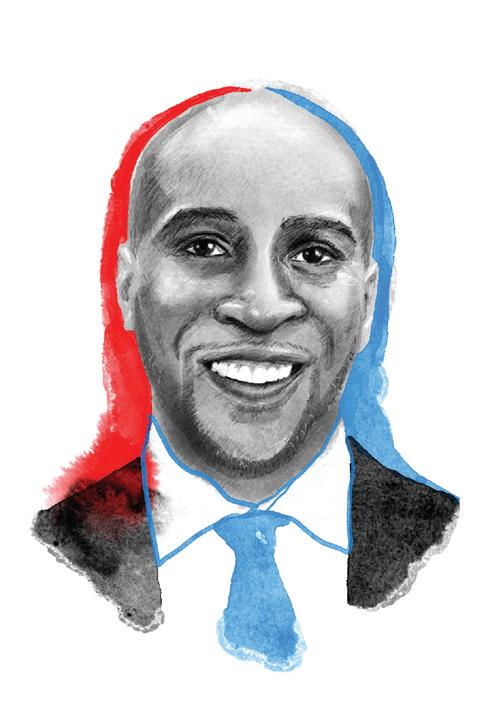
like digital media and biosciences to ensure Downtown’s role as a center of innovation and entrepreneurship. At the same time, continue to nurture existing businesses through targeted retention efforts and business development assistance.
• BUILT ENVIRONMENT Support a thriving real estate development market by coordinating incentives and tax credits to catalytic redevelopment sites near other areas of investment to maximize impact. Moreover, work with city agencies and the development community to both understand and remove barriers to the production of new uses, especially housing.
• INFRASTRUCTURE Advocate for robust, reliable and predictable public asset management (e.g., traffic control signalization, roadway maintenance, curbs/sidewalks) while developing plans for new and impactful infrastructure projects like iconic parks, stormwater management enhancements, and bicycle and pedestrian safety improvements.
• WORKFORCE DEVELOPMENT Encourage development of an inclusive Downtown economy through enhanced partnerships with DBEs, minority-owned firms, and greater New Orleans youth with a focus on education and training opportunities for future workforce needs.
• ADVOCACY AND FUNDING Advocate at all levels of government for the growth and development of Downtown New Orleans while aggressively seeking grant funds to implement new programs, projects and incentives.
• CANAL STREET REVITALIZATION Utilize all tools available to construct a multi-partnered initiative that transforms Canal Street into a vibrant retail corridor, attracting residents and visitors to shop, dine and connect with the city.
Together, we can create a vibrant, prosperous, and inclusive urban center that honors our past while embracing the possibilities of the future. T

shows
BY FRANK RABALAIS
Population trends across Greater New Orleans have been discouraging these past few years. According to the Census Bureau, from 2020 to 2023 six out of seven parishes in the New Orleans Metropolitan Statistical Area have shed residents. Jefferson and Orleans have been especially hard hit, with Jefferson Parish losing an estimated 19,004 residents since 2020 and Orleans Parish losing slightly more (down 19,861 residents since 2020).
Despite the disappointing top-line population statistics for 2020-2023, an encouraging analysis of longer-term demographic trends in Orleans Parish and Greater New Orleans was published in early July by The Data Center. The report’s findings, which went almost unnoticed, document some rather amazing phenomena. The data illustrate dramatic improvement over time in terms of educational attainment and poverty levels, from 2000 to 2023 (or from 1979/1980 to 2023, in some instances). The positive takeaways include:
EDUCATION LEVELS Nowadays, Orleans Parish has a far greater percentage of residents with a bachelor’s degree or higher than the U.S. as a whole. Fully 44% of its population is so educated, versus only 36% of the U.S. Prior to Hurricane Katrina, the New Orleans figure was just 2 percentage points greater than the nation. Additionally, the overall figure for the metro area (35%) is today essentially on par with the rest of the U.S.
The report also documents a stunning decline in the prevalence of under-education. On the eve of Katrina, a staggering one in four residents of Orleans Parish possessed less than a high school diploma. A massive improvement has transpired in the past 20 years, with only one in 10 residents of Orleans Parish today possessing less than a high school diploma. Notably, this Orleans Parish statistic now tracks the national rate in 2023, which is also 10%.
Most importantly, levels of educational attainment have skyrocketed among the city’s Black population. In 1980, fewer than one in 12 African American residents of Orleans Parish possessed a bachelor’s degree or higher. Fortythree years later, in 2023, more than one in four do, a rate greater than that of the Black population nationwide.
LEVELS OF POVERTY The poverty rate within Orleans Parish dropped by a full 6 percentage points between 2000 and 2023, from 28% to 22%. This makes New Orleans nowadays less poor than cities like Detroit (33% poverty
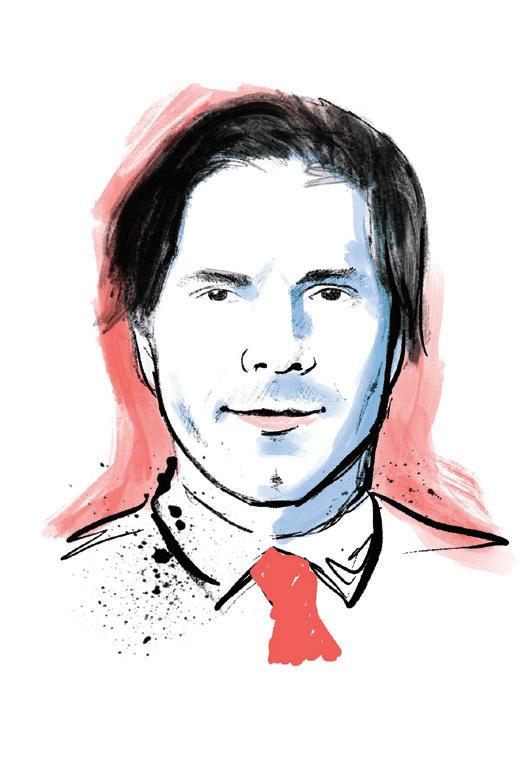
rate), Cleveland (30% poverty rate), Cincinnati (29%), Birmingham (26%), and Philadelphia (23%) and only 1 to 2 percentage points higher than Houston, Memphis, Pittsburgh, St. Louis and Knoxville, Tennessee. The metro poverty rate is also closing in on the nation as a whole, with only a 3 percentage-point difference in 2023 (16% below the poverty line here versus 13% for the nation as a whole).
Within Orleans Parish, Black, white and Hispanic people all enjoy appreciably lower poverty rates than was true in 1979, with the biggest decrease occurring among Black households. Furthermore, the enormous decline in Orleans Parish poverty rates has not been accompanied by a meaningful increase in poverty rates within surrounding suburban parishes. That is, New Orleans’ lower poverty rate has not come about simply because more poor people in Greater New Orleans live in suburban parishes than was true pre-Katrina.
In the text accompanying its report, The Data Center chose to focus on the disparities that persist among different racial and ethnic groups within the city and region, rather than highlight the positive developments I profile here. However, disparity among different racial and ethnic groups is a national phenomenon, present everywhere. Only the degree varies. I would argue, therefore, that the real story the report tells is our local success at accomplishing what is, in truth, the far harder work of leveling up the fundamentals.
The foundation for generating and sustaining economic growth in our region is now far stronger than ever before. We are no longer profoundly under-educated and cripplingly poor. Our top priority today — what we must demand of our political leaders, business owners and other key decision makers — must be a laser-focus on regional economic growth, and on the policies and reforms that will enable this. Only by growing the overall size of the pie can we succeed at narrowing the gap in incomes and net wealth across race and ethnicity in our city and region and reverse Greater New Orleans’ recent population decline. T

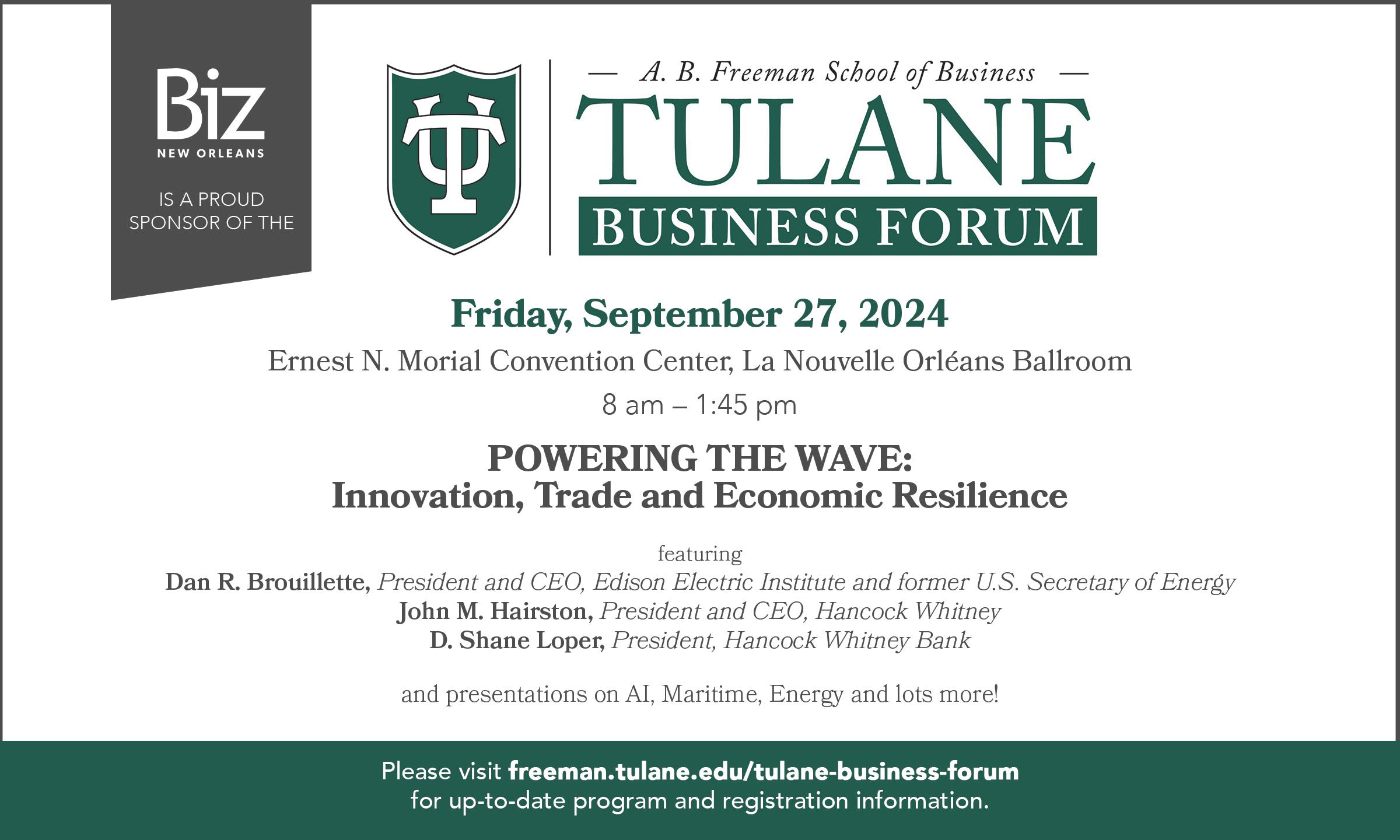
BY KIM SINGLETARY

EDMUND D. FOUNTAIN
WITH JUST OVER FIVE MONTHS UNTIL SUPER BOWL 59, THE NEW ORLEANS SUPER BOWL HOST COMMITTEE IS CHARGING FORWARD, SPURRED BY A MESSAGE IT WANTS THE WORLD TO HEAR.
4th
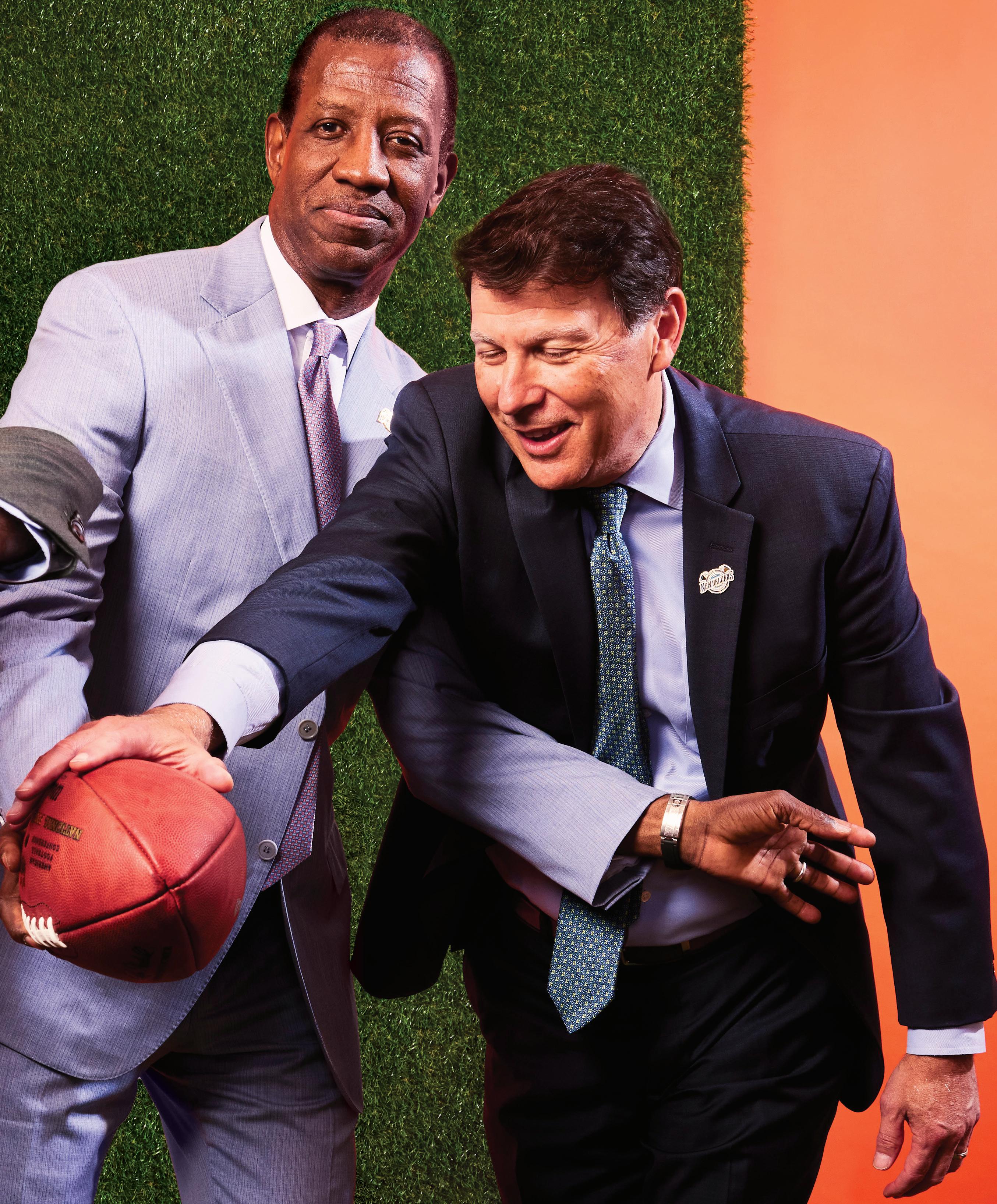
THAT’S WHEN THE SAINTS and Greater New Orleans Sports Foundation learned they had been awarded the 2024 Super Bowl. It was the 11th time New Orleans had received this news, tying the city with Miami for the most times a city has hosted the colossal event.
But in 2021, the NFL decided to expand from 16 to 17 regular season games. Unfortunately, this pushed the date of the 2024 Super Bowl into the height of Carnival Season — on Bacchus Sunday.
Fortunately, the Saints and GNOSF anticipated the possibility of a change and had written into the contract that if extra games created a conflict, the city would be awarded the next available Super Bowl. In October 2020, New Orleans was confirmed for the 2025 game instead.
Working around surprises and anticipating potential issues is all part of the job, and it’s one Jay Cicero knows well. President and CEO of the Greater New Orleans Sports Foundation, Cicero is serving for the third time as president and CEO of the Super Bowl Host Committee — he previously led the committees in 2002 and 2013. Back even further, he served as VP of operations for the host committee in 1997.
Cicero is well aware of the opportunity that hosting America’s biggest televised event every year poses for the city. This year’s 2024 Super Bowl — where the San Francisco 49ers played the Kansas City Chiefs in Las Vegas — earned the title of the most watched program in U.S. history. An average of 123.4 million viewers watched the game — representing about a 7% increase over 2023 Super Bowl viewership.
As with tackling any big endeavor, the key is to get the right people on board to plan it. Two years ago, the New Orleans Saints and GNOSF asked Marcus Brown, executive vice president of Entergy (founding partner of the host committee), to serve as chairperson.
As chair, Brown named all the chairs and co-chairs of the 16 different subcommittees charged with handling different aspects of the event. Among them is the Infrastructure and Economic Development Committee, which is led by Michael Hecht, president and CEO of GNO, Inc. Hecht was also involved in the 2013 Super Bowl, where he worked with then-Mayor Landrieu to get the message out that New Orleans post-Katrina was not only back, but better than ever. With the clock ticking to the big day — February 9, 2025 — Biz New Orleans recently sat down with all three leaders to chat about their vision for what Super Bowl LIX could mean for New Orleans’ future long after the Vince Lombardi trophy finds a new home.
Let’s jump right in with a big, overarching question: What is the main message you want to get out with this Super Bowl?
JAY CICERO There are a lot of messages. For one, it’s a new day in Louisiana and New Orleans. You see this with all the new economic development efforts, which Michael and his group are heading up. You also see how tourism has grown so much in the past 11 years. We want to use this opportunity to tell the 6,000 members of credentialed media who come and cover Super Bowl week about all the great things that are happening in Louisiana and New Orleans.
We have a very active media/PR subcommittee, which is led by Mark Romig. Mark and Rob Hatley from Entergy, are chairing that statewide committee which has, I think, 80 or 90 people on it. Michael sits on that also.
MARCUS BROWN One of the things that we are really focused on is that the country is going through a clean energy transition and Louisiana is the gateway of that. Working closely with Michael and the Economic Development Subcommittee, we think that when we get those corporations, those leaders coming into our region, it’s a great opportunity to sell them on some of the other things we have.
MICHAEL HECHT And just to tag on to what Marcus said from the state perspective — because we’re working very closely with Secretary (Susan) Bourgeois at Louisiana Economic Development — of all the economic diversification and growth opportunities right now, by far the largest is energy and the energy transition. One of the themes that the state is talking about is “Louisiana, the energy of innovation.”
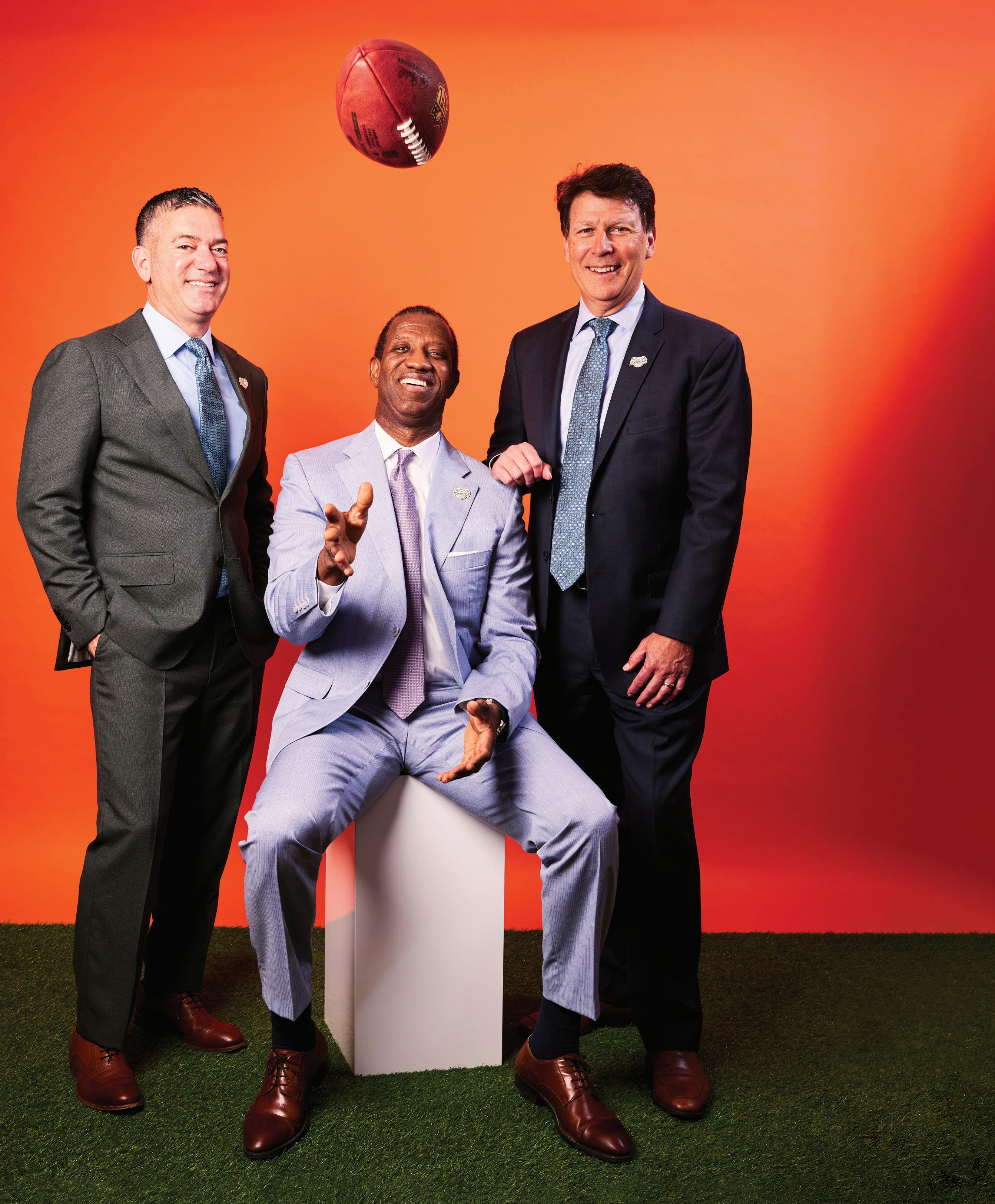
SUPER BOWL LIX PICK? Saints defeating the Chiefs
FAVE DOME FOOD? Classic Dome Dog
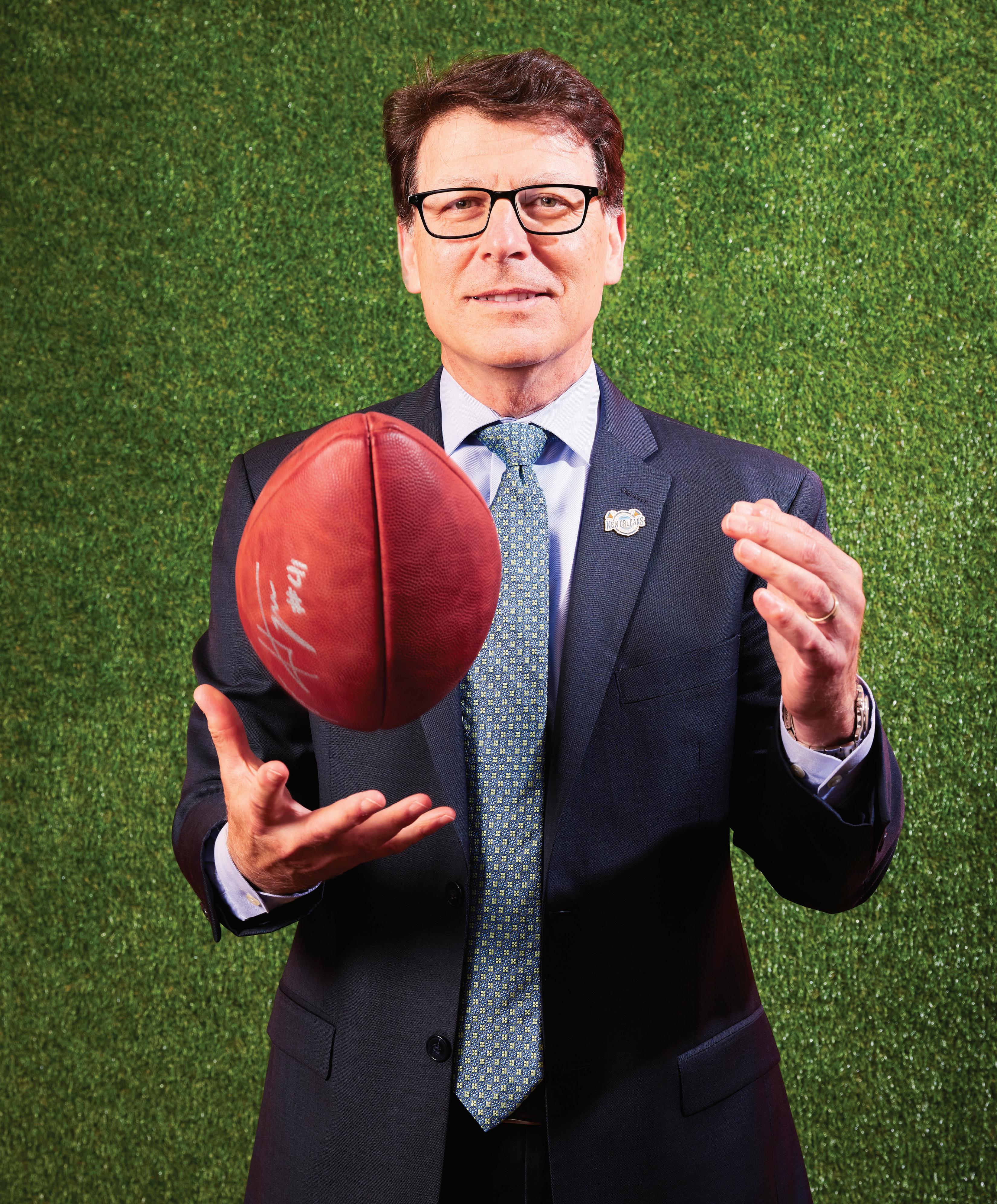
NAME POSITION President and CEO of the Greater New Orleans Sports Foundation; president and CEO of the Super Bowl Host Committee
FAVORITE ALL-TIME PLAYER? Drew, of course, with Taysom Hill as a close second
2ND STRING TEAM? Varies each year. Will follow the Lions this year
And that, of course, plays in directly to what Marcus was talking about, about us being national, international leaders in this energy space. There will be a lot of stories and themes and tours and facts about the billions that’s being invested in lower carbon energy in Louisiana.
JAY CICERO Another one of our messages is our record-tying 11th Super Bowl with Miami. We’re really leaning into the history of Super Bowl in New Orleans… It goes along with the historic theme New Orleans carries along with it. We have been able to work with the league to get the use of the 10 game logos, the 10 previous artworks for the game tickets, the 10 previous covers for the game programs, and then various video clips of previous games, so we’ll be showcasing all of that. It really all goes to show that Super Bowls are what we do here.
MARCUS BROWN We think about it in terms of this building crescendo, because a community, a state, a region, puts on a Super Bowl. What you’re trying to do is bring along the entire region, and you want thousands of volunteers to be ambassadors. You want people on the street to be informed enough to be great hosts. You want these 6,000 media people to have great stories to tell from all over the region and over the state about what’s going on here.
Our job is to lay the groundwork for this growing storytelling, building and inclusion of all these people along the way. By the time you get to the game, you’ve got an entire region vested in making sure that the experience is one that’s unforgettable for participants, and that the benefits last well beyond the game.
Michael, on the infrastructure subcommittee side, what is happening right now?
MICHAEL HECHT
(money) is federal or private sector, for example, supporting our homeless encampment strategy.
As you said, a lot of this infrastructure work has been long overdue. Do you think what is happening now will inspire us enough to keep from falling this far behind again?
MICHAEL HECHT Some of the great revelations and joys of this process is that there’s so much enthusiasm and capacity for teamwork that we’re seeing not just within the city, but between different levels — between the city and the state Sewerage and Water Board. And when I talk to Joe Threat, who’s leading this effort as the infrastructure coordinator for the
RIGHT NOW FOR THE SUPER BOWL WE’RE IN THE LAST QUARTER OF OUR FUNDRAISING, TO USE A FOOTBALL TERM, AND WE’RE HOPEFULLY GETTING DOWN TO THE TWO-MINUTE WARNING PRETTY SOON. — JAY CICERO
The stuff that you’re probably starting to notice now, for better or worse — if you ask my staff who’s trying to get over the bridge this week — is that there’s a punch list of well over 500 projects that are being worked on by about three dozen different agencies... city ones like Department of Public Works... state ones like the transportation department, Sewerage and Water Board, and then the Superdome, the Downtown Development District, the French Quarter.
Some of these are very small projects, like filling in individual potholes or repairing individual lights. Some of them are as large as what we’re going to do with Plaza Tower or the programmable lights going on the bridge. But collectively our goal is to do three things: One is to put on an outstanding Super Bowl that’s centered in the entertainment district, and the epicenter of which is the French Quarter.
The second is, what Marcus and Jay were talking about, to demonstrate our physical capacity to have such an outstanding experience for fans in the media and the NFL that it makes the case for us to host a record-setting 12th Super Bowl.
Finally, there’s the internal sell to the citizens of New Orleans — and why we’re able to ask for their forbearance right now with all the work that’s being done — that these improvements that we’re making are not just cosmetic for the game. We’re taking on years of projects that need to get done and the benefits are going to be enjoyed by the citizens of the region for years, and maybe decades to come. It’s really using the Super Bowl as a forcing function for massive infrastructure rejuvenation.
MICHAEL HECHT It’s a range of sources, from a lot of the agencies — their operating budgets or their capital budgets. There were some special outlays that were made during the past legislative session for the Super Bowl, and then some
city, he loves the idea of continuing this rhythm that we established with once- or twice-a-week meetings. I really think, to use kind of a sports metaphor, that we’re now developing the muscle memory for an action that I think we’re going to be able to repeat far beyond the Super Bowl.
MARCUS BROWN And the other half of that idea of making long-lasting change is people. You think about the Impact 59 grant program that we have, where the NFL has put up $1.5 million in the matching grant program, which is a collaboration with the Saints, Entergy, Ochsner Health, the United Way of Southeast Louisiana and NOLA Coalition, and other organizations, that are still contributing to that program to award at least $3 million in grants to local nonprofits. That impact is going into these communities, funding these necessary programs, where people are making differences that matter well beyond February 9.
What kind of programs are you talking about, Marcus, that will be receiving funding from Impact 59?
MARCUS BROWN Programs dealing with workforce development, education, environment, poverty, solu-
tions — those are the kinds of things that we’ll be trying to fund. There’s a committee associated with the grant program, and they’ll be taking in grant applications. It’s administered by the United Way…We can’t boil the ocean, so we really want to focus in on a few areas where we could have more impact.
This all feels like it’s happening on a very short timeline. Does it feel that way to you?
JAY CICERO I think Michael’s area is probably one of the shorter timelines to accomplish a whole lot. But again, we’ve been working on this for several years leading up to this point. Probably one of the first things we started was the marketing and fundraising committee — you have to raise the funds to help offset all the bid commitments that we made back in 2018 — and so that effort started a few years ago.
JAY CICERO It’s a combination of public and private funds. There is a grant from the state of Louisiana through the State Major Event Incentive Fund that we helped create as a sports foundation seven or eight years ago. At the time we were bidding on the 2020 College Football Playoff Nationa Championship game (which we received and LSU happened to win). We’ve used the grant for the NBA All-Star game, for the NCAA Men’s Final Four and, other major events that come along.
Right now for the Super Bowl we’re in the last quarter of our fundraising, to use a football term, and we’re hopefully getting down to the two-minute warning pretty soon.
All in all, how many people are involved in pulling this all together?
JAY CICERO I’d say close to 1,000 at this point, when you include everyone. The Security Committee is probably 500 people by itself, when you consider all the agencies working together, and all the sub-groups that they have. That’s an event in itself. I have to really emphasize that Mrs. Benson and the Saints are such a big part of this. Quite simply, no Saints, no Superbowl.
Think about what you’ve heard at the Olympics using cardboard beds, that’s thinking in advance of a big event, so that it doesn’t leave a negative impact.
involved with that?
MARCUS BROWN The chair is Elizabeth Adams, who’s from Entergy, and it’s got a cross-functional group of leaders from a lot of companies from the region.
What do you see as the biggest challenges going forward? Michael, you have said that you have your own personal pothole; that if it’s not filled by the night before the game you’ll be out there with a shovel.
MICHAEL HECHT It’s really funny. I was actually talking this morning to somebody who may or may not be the announcer for the Saints, whose father may or may not have done it for 44 years. And he said, “Michael, there’s this one pothole I want to talk to you about. It’s right when you’re getting on … ” — I said, “That’s my personal pothole!” We checked with DPW, and there’s a notice to proceed on August 9 with work to start by August 15. One of the things that’s exciting about this is that, because of the compressed timeline, there’s a sense of urgency, and we’re able to see results fairly quickly, and I think that’s helping to create the momentum.
I have to ask, where is this pothole?
MICHAEL HECHT It’s at the entrance to I-10, at the intersection of Claiborne and Poydras. Tesla’s and other autonomous vehicles have it programmed into their software so they know to swerve. I guess they’ll have to be reprogrammed soon.
JAY CICERO Fundraising is one of the largest challenges that we have, and I said we’re in the last quarter of that right now. It’s a daunting task to raise private funds needed in a state where we only have two Fortune 500 companies.
WE’RE GOING TO USE THE SUPER BOWL AS AN OPPORTUNITY TO TALK ABOUT THE URBAN CORE OF THE REGION AS A PLACE FOR ENERGY TRANSITION COMPANIES TO LOCATE THEIR HEADQUARTERS OR THEIR REGIONAL OFFICES, THEIR PEOPLE AND THEIR FAMILIES. — MICHAEL HECHT
MARCUS BROWN Let me put the plug in very quickly for the Sustainability Committee, because if you think about the impact that a Super Bowl can have on the community, you know, potentially negatively when it comes to waste, this committee is thinking of what we can do to limit that.
The fundraising we do, however, is important because it helps us to be competitive with other cities and keep the costs lower in New Orleans than other cities. The Sports Foundation will basically donate our staff for the entire time, except for the staff that that we have to hire just for Super Bowl. It’s about being resourceful, as only New Orleans can do. We’re very resourceful people. We find ways to do things and deliver things better than other cities at less cost.
MARCUS BROWN That leads us to something else we’re focused on right now, and that’s the volunteers. We’ve got a need for thousands of volunteers to work in the Super Bowl and support the fan base in a lot of different ways. I think September 27 is the deadline to send in applications for those who want to participate in the
SUPER BOWL LIX PICK? Saints against the world!
FAVE DOME FOOD? Bloody Mary with the works
NAME POSITION President and CEO of GNO, Inc.; Chair of Infrastructure and Economic Development Subcommittee michael hecht
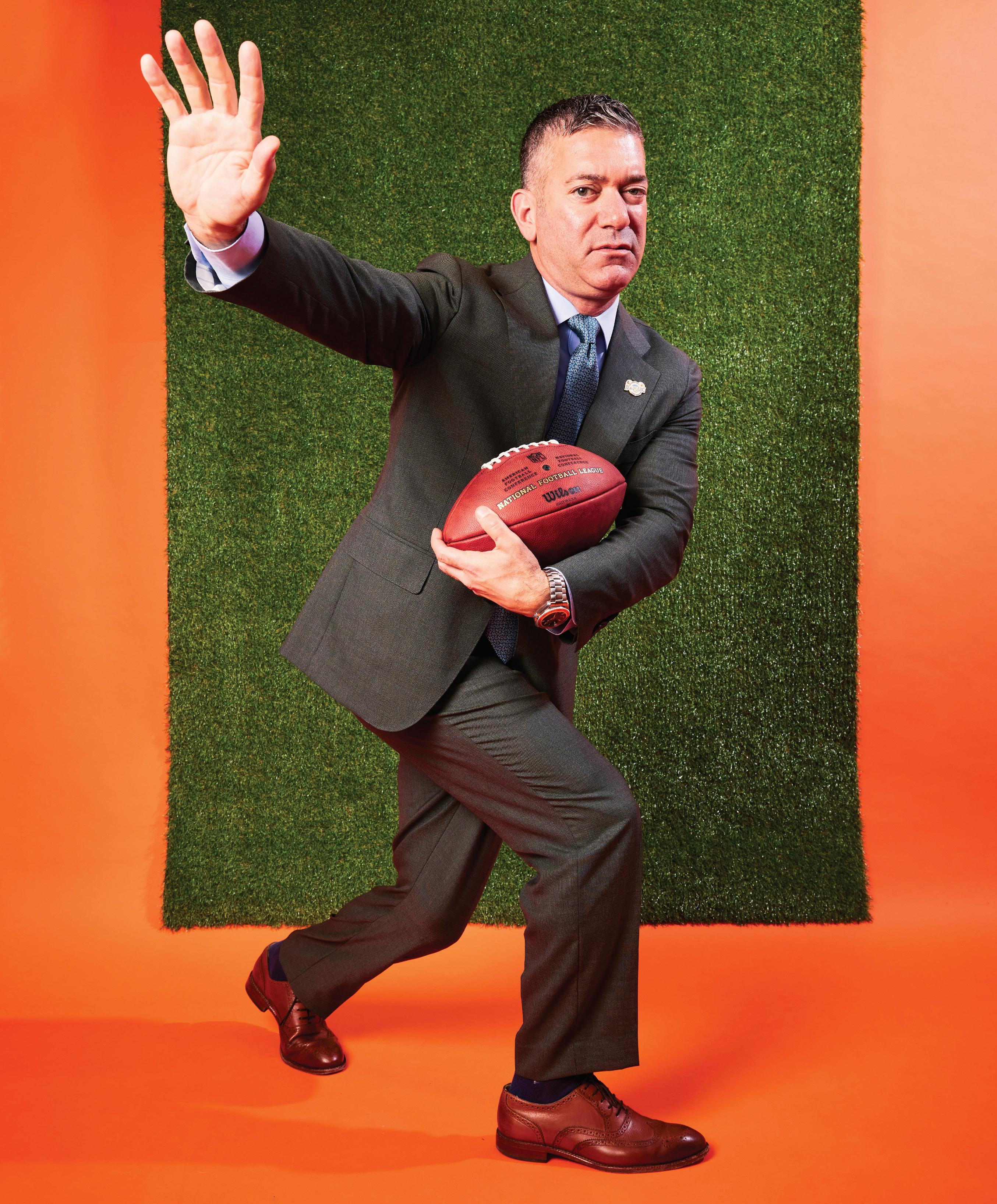
2ND STRING TEAM? The Giants
FAVORITE ALL-TIME PLAYER? Morten Andersen — “The Great Dane”
My dream scenario would be the Saints versus the Bengals ( Burrow).
SUPER BOWL LIX PICK?

FAVE DOME FOOD? Beau Coup BBQ and a Big Freezy Daiquiri
Executive Vice President of Entergy; Founding Partner and Chairperson of the Super Bowl Host Committee
POSITION
FAVORITE ALL-TIME PLAYER? Drew Brees or Ricky Jackson— hard to choose one.
2ND STRING TEAM? Saints fans don’t have a second favorite team. It’s ride or die with the Saints.
ambassador program, which is being sponsored by Chevron. Anyone at least 18 can go to NolaSuperBowl.com and get more information.
JAY CICERO They’ll be working meet-and-greet at the airport, first, and at the private airports, as well as working Downtown and at our special events that we’re hosting. We’re leaning into this history of the Super Bowl theme, so there are going to be phone games that our ambassadors are going to engage tourists and visitors to play about the history of Super Bowl in New Orleans to win prizes.
You’ve mentioned some big companies like Chevron and Entergy and Ochsner; what are the opportunities like for other businesses to capitalize on the Super Bowl?
JAY CICERO Right after the 2024 Super Bowl in Las Vegas we started the Supplier Diversity Program. It’s now called the NFL Source. The NFL uses it not only for Super Bowl, but for the draft and all the other major events that the NFL produces each year.
an opportunity to talk about the urban core of the region as a place for energy transition companies to locate their headquarters or their regional offices, their people and their families.
Our ability to project a place that has excellent infrastructure, of course wonderful culture and wonderful people, but that also has an energy and an excitement, and a positive momentum is all part of this overall recruiting strategy for these large energy transition companies from around the world.
WE THINK ABOUT IT IN TERMS OF THIS BUILDING CRESCENDO, BECAUSE A COMMUNITY, A STATE, A REGION, PUTS ON A SUPER BOWL. WHAT YOU’RE TRYING TO DO IS BRING ALONG THE ENTIRE REGION, AND YOU WANT THOUSANDS OF VOLUNTEERS TO BE AMBASSADORS. YOU WANT PEOPLE ON THE STREET TO BE INFORMED ENOUGH TO BE GREAT HOSTS.
— MA RCUS BROWN
We have more than 120 local, diverse businesses involved in the Super Bowl LIX Source here in New Orleans, and they will have the opportunity to bid on business from the NFL and Super Bowl. It’s about not only opportunities for bidding, but the ability to learn how to improve your business by working through a professional organization like the NFL and its education programs. The Source now will be living with the New Orleans Saints after Super Bowl. That’s a legacy piece of all of this.
JAY CICERO The economic impact from 2013’s Super Bowl was about $480 million, but then what we also saw happen is we had a heck of a lot of business, especially tourist business, business conventions, that were booked after the Super Bowl. We need to be able to turn that long-term bump on for more sectors in the business community.
Michael, what are you hoping to achieve when it comes to boosting our emerging energy sector?
MICHAEL HECHT Right now, Louisiana is arguably best positioned in the nation to lead the energy transition to an all-of-the-above, lower-carbon future. I’m talking about what we’re doing in traditional sectors like oil and gas or LNG. It’s also newer sectors like hydrogen and biofuels and wind and solar.
The way that we’re trying to play this, working with the state and other economic development organizations, is that there are these companies that are investing literally tens of billions of dollars — for example, we have perhaps $60 billion worth of potential carbon capture projects in our pipeline. Those companies are going to be locating those facilities along the river and in industrial parts of the state. We think that’s fantastic. It’s exactly where they should be in terms of infrastructure. But then there’s an opportunity for them to put their headquarters in the urban core, in places like Downtown New Orleans and Jefferson or the North Shore. We’re going to use the Super Bowl as
I’m assuming affordability is a part of the sell as well, because we have pretty affordable office space.
MICHAEL HECHT Yeah, it’s affordability. It’s the alacrity that you’re seeing now from the state with the governor and the economic development secretary. It’s our suite of incentives which are about as good as any place in the country. It’s our partners, first and foremost, Entergy, truly as an industrial partner, and then just a business community and leadership that I think is second to none in terms of the willingness to get involved and help make companies feel comfortable.
Altogether, I think it’s an unbeatable package. The challenge that we typically have is that we just don’t have the scale — back to what Jay said earlier — in terms of the size of the state or money, to really have the presence that a Texas, for example, would have. Hosting the Super Bowl for about five days, however, dramatically changes that map by putting us in front of 200 million people. It’s a marketing opportunity that is unparalleled for us, and so we aim to take advantage of it. T
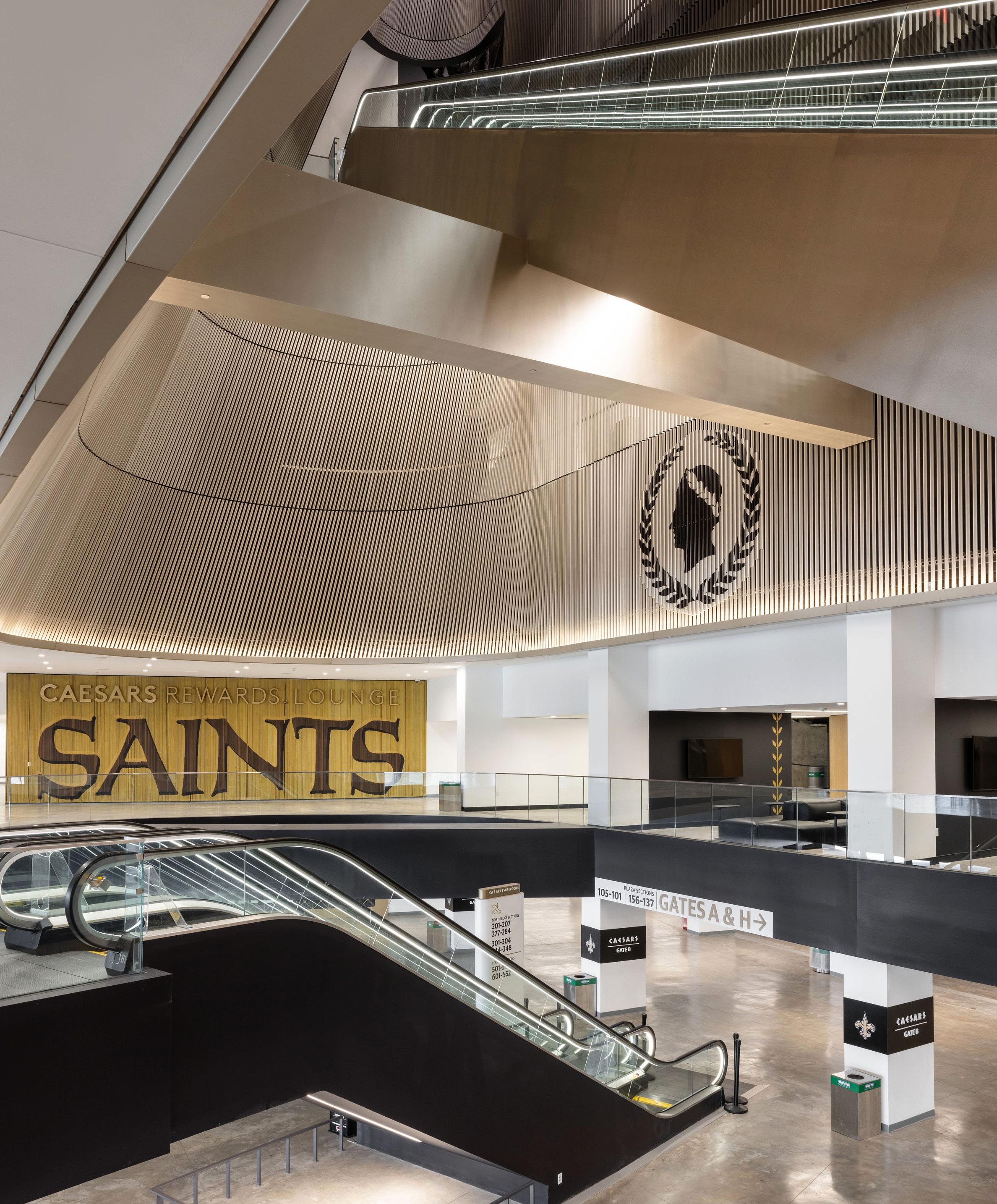
FRESH OFF A HALF-BILLION-DOLLAR RENOVATION, CAESARS SUPERDOME IS READY TO KICK OFF
THE SEASON... OH YEAH, AND PLAY HOST TO THE MOST-WATCHED TELEVISED EVENT IN AMERICA.
BY
WHEN CONSTRUCTION of the Louisiana Superdome missed its 1972 completion deadline by three years, it caused Super Bowl IX to be held in a cold and rainy Tulane Stadium in January 1975. During a break in play, broadcast cameras aimed down Claiborne Avenue showing the unfinished stadium, and the analysts covering the game called the unfinished building a “white elephant.”
It has turned out to be anything but.
According to GNO, Inc., President and CEO Michael Hecht, the Superdome contributes close to $600 million in annual economic impact to the state of Louisiana, as monied attendees fill hotel rooms, restaurants and shops for several days before many events. When a major championship like the Super Bowl comes to town, those figures can nearly double. The U.S. Chamber of Commerce reported that Super Bowl LVIII, held in February 2024, brought at least $500 million to the Las Vegas metro area, including $70 million in local and state tax revenue.
For 49 years, the Superdome has been home to the New Orleans Saints and has regularly played host to high-profile events, including not only the Super Bowl, but the College Football Playoffs and Championship, NCAA Final Four, the Sugar Bowl, Bayou Classic, New Orleans Bowl and many more. These events have not only generated millions of dollars that directly impact the local economy, but billions in added value through the multi-day, round-theclock global media coverage and national broadcasts that accompany them.
Several multi-million-dollar renovations over the last 20 years have not only extended the life of the building but kept the Dome competitive with, and, in some cases, standing longer than newer stadiums.
The latest refurbishment, focused on improving the fan experience, is a $535million endeavor that started in 2020. This latest iteration of the city’s famous land-
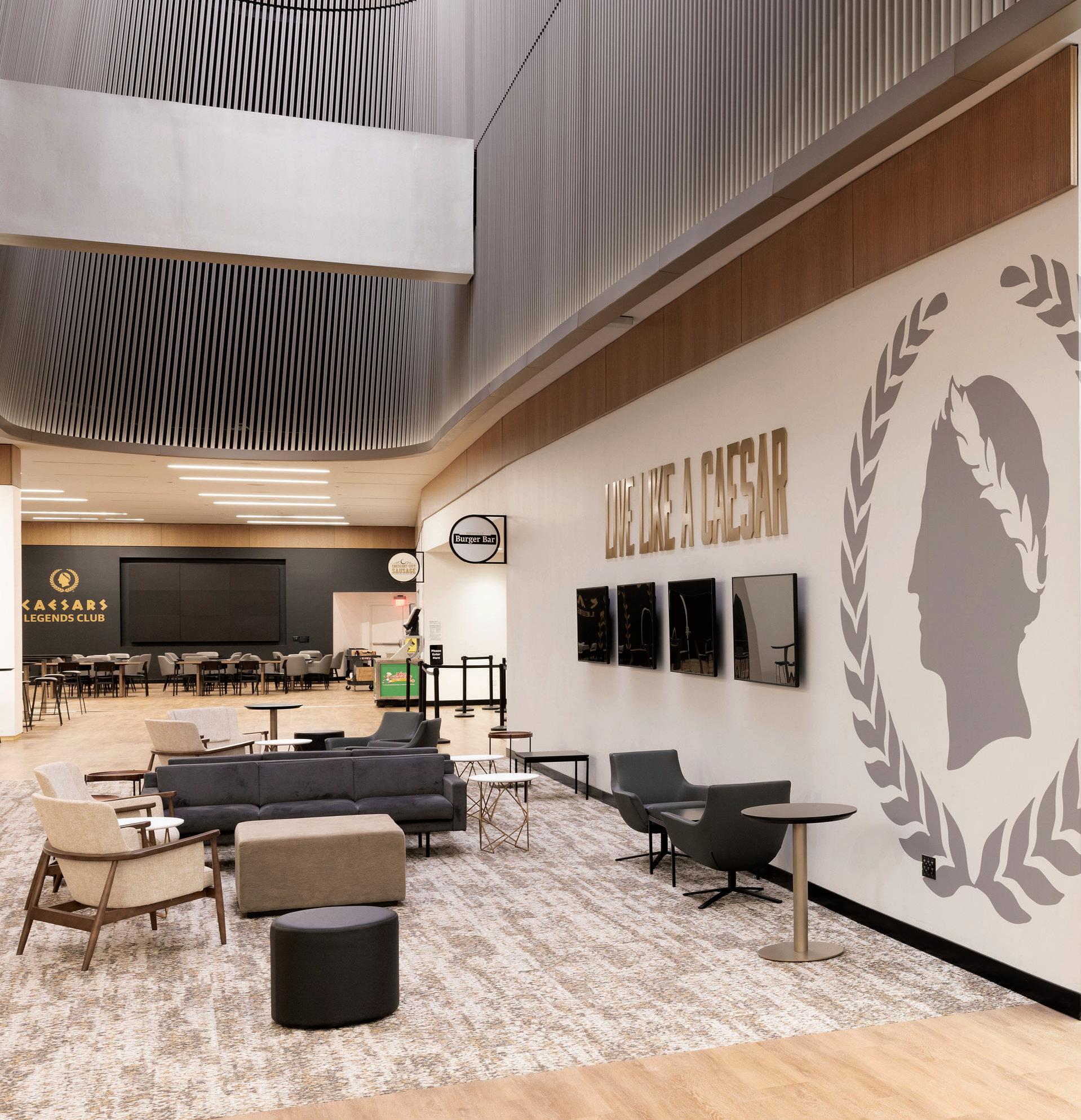
DID YOU KNOW?
Monsanto, maker of the first artificial playing surface, AstroTurf, created “Mardi Grass,” an artificial turf made specifically for the Superdome that was in place from 1975 until midway through the 2003 football season.
mark will be on full display as New Orleans takes centerstage as host of Super Bowl LIX on February 9, 2025.
When the NFL awarded New Orleans a franchise on All Saints Day, Nov. 1, 1966, the deal came with an understanding that the new club would play indoors. Local businessman Dave Dixon, who worked nearly a decade of work to bring a professional football team to the city, worked with then-Gov. John McKeithen to endorse financing. A week after the Saints came into existence, bonds were passed for construction.
New Orleans architectural firm Curtis and Davis designed the dome in 1967 as a shell over a multi-sport facility with ground-level stands on rollers that could be configured for football, baseball, basketball and special events. Expected to open in 1972 at a cost of $46 million, construction did not begin until August 1971. The 1973 oil crisis, inflation and delays drove
costs up to $165 million by the time it was completed in August 1975.
The Superdome’s $165 million cost is considered an amazing bargain today, especially when accounting for the longevity and the exposure the Dome has provided to the city and state.
Only four of the NFL’s 32 stadiums are older than New Orleans’, and the three most recently built all cost between $1.6 billion and an estimated $5.5 billion (2020).
Considering the Superdome is in its 49th year and will continue to draw premier events well into the future, Jay Cicero, president and CEO of the Greater New Orleans Sports Foundation, the organization whose mission is to attract and manage sporting events to the Greater New Orleans area, said the region got a fantastic deal with the Superdome.
“It’s hard to compare dollars, early ’70s to 2020s, but when you look at the facility
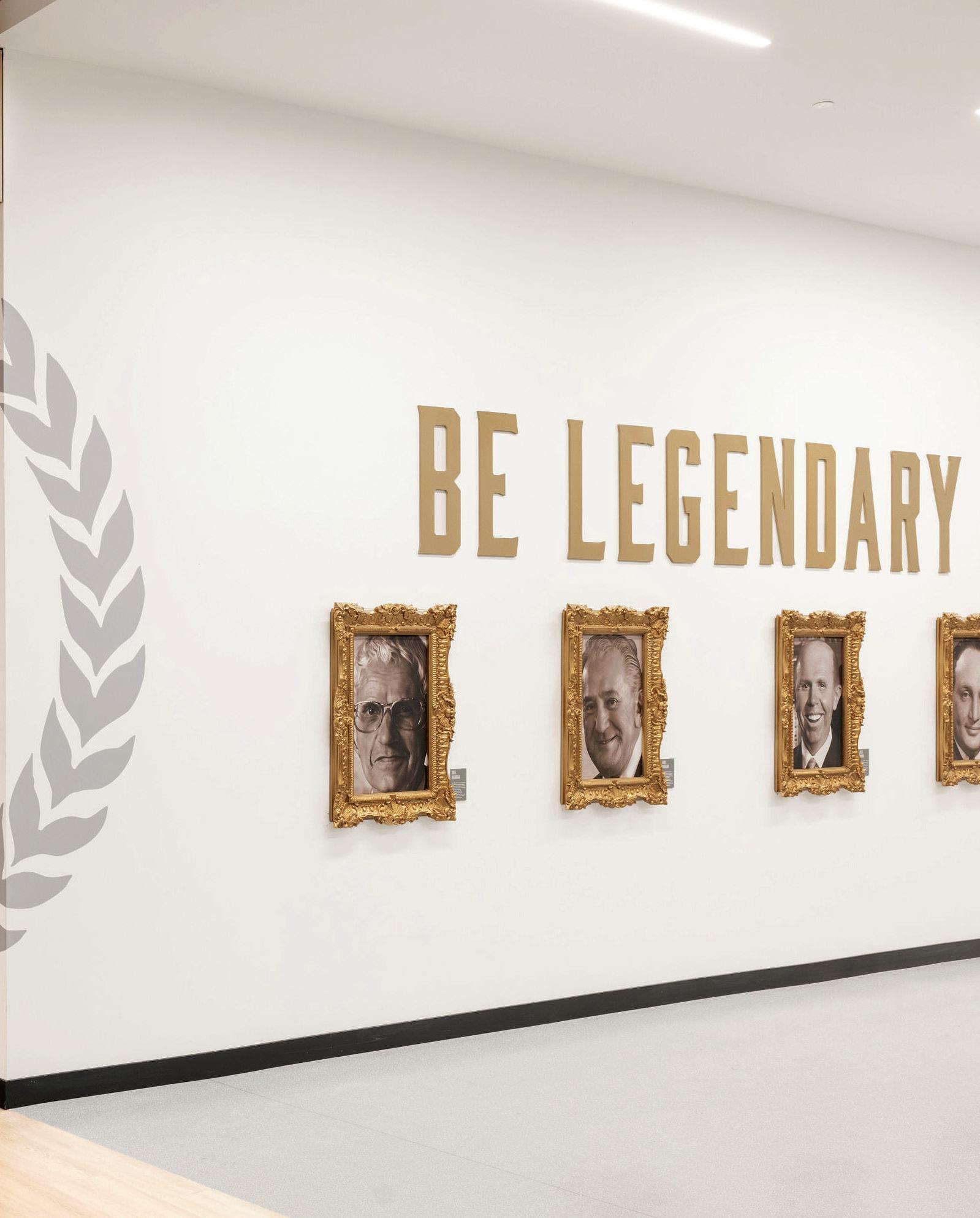
that we have, the historic nature of it, and that it was built for the long run compared to facilities in other cities that have been constructed, torn down and replaced with a new facility maybe two or three times since 1975, it’s pretty amazing,” Cicero said. “I don't know if there are enough superlatives for the Superdome when you consider the value and revenue it’s provided.”
What still stands as the largest fixed dome structure in the world was almost changed in the early 2000s, when the idea of a new retractable roof stadium to replace the Superdome was floated. At that time, the Saints compared modernizing the Superdome or building a new retractable roof stadium on the banks of the Mississippi River or possibly on the North Shore to attract a more regional fanbase.
Those plans were put to rest on Aug. 29, 2005, when Hurricane Katrina ravished the Gulf Coast and inundated New Orleans, flooding nearly 80% of the city. The storm’s

of the Saints. “That was No. 1, bringing it back. Once that decision was made, the direction was set.”
winds ripped the Dome’s protective rubber-like shell from its roof, exposing the interior to the weather. Flood waters covered the field that just days before hosted a preseason game.
Images of the Superdome’s devastation became ubiquitous. Soon questions arose about its future, as well as those about the Saints, who were forced to relocate to San Antonio, Texas, for the 2005 season.
The nation, city, state and NFL worked alongside the Saints to return to the Superdome. FEMA provided $115 million, the state spent $13 million, the Louisiana Stadium and Exposition District (Superdome Commission) refinanced bonds to generate $41 million, and the NFL gave $15 million toward a $185 million, fast-tracked repair and refurbishment.
Soon, the stadium’s recovery became a microcosm of the city’s rehabilitation, inspiring pride and hope.
“The rehab after Hurricane Katrina was basically to get the building back together,” said Dennis Lauscha, president
Super Bowl XII in January 1978 between the Dallas Cowboys and Denver Broncos (27–10 Cowboys) was the first played in the Superdome and the first broadcast in prime time.
The Superdome’s grand reopening was held on Sept. 25, 2006 — the home opener against the arch-rival Atlanta Falcons in a nationally televised game on ESPN’s Thursday Night Football. After the Falcons’ first possession, the Saints’ Steve Gleason blocked a punt that was recovered for a touchdown. ESPN’s announcers remained silent for more than two minutes as cameras panned around the Dome showing elated fans shrugging off misery of the storm and its aftermath and embracing the limelight of the comeback. With no question that the Saints would win that game, Atlanta succumbed 23-3.
Les bons temps were just getting started, however. Under first-year head coach Sean Payton and quarterback Drew Brees, the Saints went to their first NFC Championship in 2006. In 2009, they would reach the pinnacle, winning their first NFC Championship at home, followed by their first and only Super Bowl win in Miami on Feb. 7, 2010.
Following the post-Hurricane Katrina repairs, work continued to update the
Caesars Superdome is the fifth oldest stadium in the NFL. Chicago will celebrate Soldier Field’s centennial this season. Next year, New Orleans will fete 50 years in the dome.
Soldier Field
Chicago opened 1924
100 years old
Lambeau Field
Green Bay, Wisconsin
opened 1957
67 years old
Arrowhead Stadium
Kansas City, Misssouri
opened 1972
52 years old
New Era Field
Buffalo, New York
opened 1973
51 years old
Caesars Superdome
New Orleans opened 1975
49 years old
The Superdome sits on 70 acres of land. It is so big that Houston’s Astrodome could fit inside it.
DID YOU KNOW?
When adjusted for inflation, the $165 million cost to build the Superdome in 1975 would equate to a little more than $963.5 million in 2024, according to CoinNews’ online U.S. Inflation Calculator.
Dome. In 2008, windows were added to allow natural light inside, and the roof was replaced. Over the next two years, more than 400,000 square feet of exterior aluminum siding was replaced, giving the Superdome a champagne-colored exterior. Suites were modernized and a $600,000 point-of-sale system that allowed fans to make credit card purchases throughout the stadium was installed.
In 2011, the Plaza level was reconfigured to add 3,500 leather chairs with cup holders, create two 7,500-square-foot lounges, widen concourses, and add new restrooms and concession stands. These changes also ended the dome’s ability to convert to a baseball configuration.
In 2016, Panasonic HD LED displays that stretch 330 feet wide and 35 feet high were added above the Terrace level seating at both ends of the field and the interior lighting was upgraded to an LED system with programmable coloring, light show effects, and instant on-off, which allows for dynamic in-game entertainment.
The latest round of renovations began in January 2020. Over the last four years, a large kitchen and food-service area was built, the ramp system was removed and replaced with elevators and escalators, concourses were widened, and new bathrooms, walkways, entrances and exits were added, along with a Wi Fi system, standing room-only platforms, and field-level end zone boxes. Construction finished just before the kickoff of the 2024-25 football season.
“It’s amazing, and this really gets overlooked, that all these renovations happened without missing a football game or an Essence Festival,” Lauscha said. “We got it done on time and on budget.”
Superdome stakeholders said the most recent renovation was focused on providing the greatest fan experience possible.
“The removal of the ramps allowed us to open up the concourses, add more concessions and bathrooms, and make moving around the stadium easier, especially for our ADA customers,” Lauscha said. “We listened to the fans and vendors. They wanted easier entryways, open concourses, outside light, suites on the field, and more amenities on the Terrace level, so we added that. At one spot, you can literally look across the field through the new glass on the other side and see the buildings in Downtown New Orleans from the gate. It truly is a modern building now in every way. I think it’s spectacular.”
Jeff Hundley, the CEO of the Allstate Sugar Bowl, said the WiFi upgrade is something that will have tremendous impact.
“That’s super important with the way people utilize their phones,” he said. “For communication, for information, for the purchase process, that requires additional bandwidth. All those things add up to a positive experience.
“In the event business, fan experience is a No. 1 priority right now,” Hudley added. “It’s no longer enough to just have a good football game on the field. There are things going on all the time. We must give people reasons to want to be in the stadium because the television product has become so good.”
Winning the rights to host Super Bowl LIX in February was just the first of what is expected to be many returns on the investment in the Superdome.

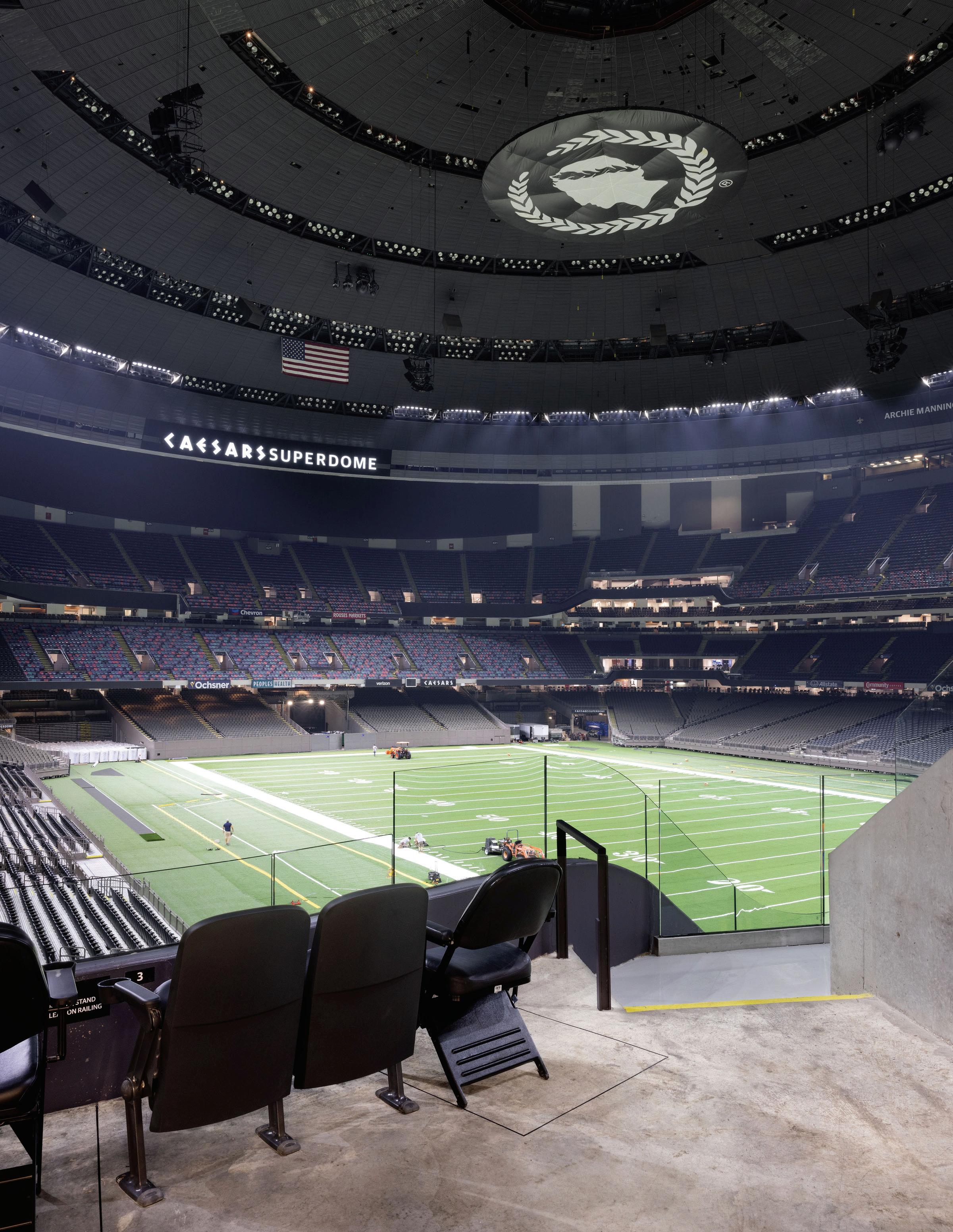
“This renovation allows the Superdome to be what it has for the last 50 years, a critical asset and economic generator,” said Evan Holmes, general manager of the Caesars Superdome. “It’s the home of the Saints, the Sugar Bowl, the Bayou Classic, Essence Fest, New Orleans Bowl, high school football, Endymion. Go down the list. These are legacy events that we’ve had for decades. A lot of these other facilities don’t have that roster, and they would kill to have that level of built-in annual events. That’s why we did this: It allows this building to be a more modern, higher functioning multi-
purpose facility to carry on all the things it has historically. This is a continuation of the success of this building.”
In July, The Times-Picayune writer Jeff Duncan reported the Saints are looking to extend their lease at the Dome, which runs through 2030, to 2035, and include multiple five-year options that could keep the team in New Orleans through 2055. If that happens, it is not unfathomable that the city could host multiple NFL championships in that time.
“I’ve been to every stadium in the NFL, and I’m biased, but after these renovations,
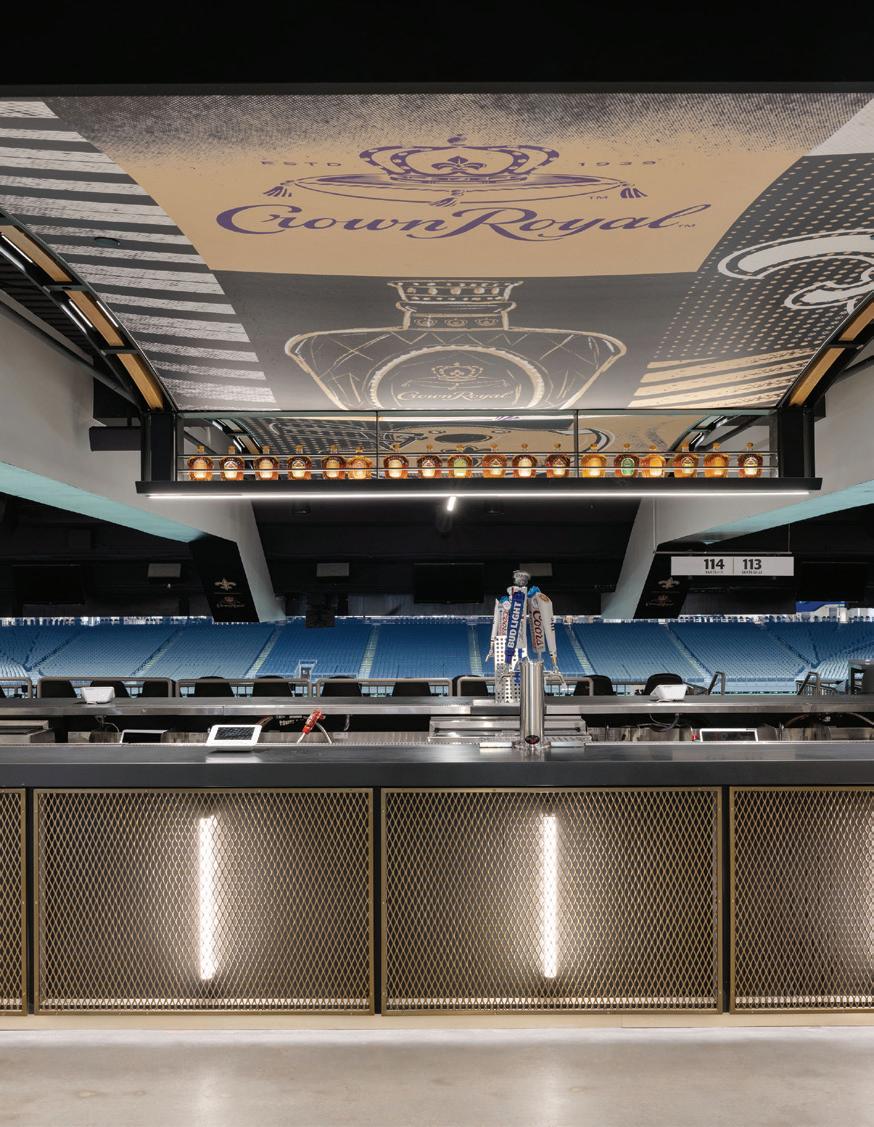
I’d hold the Superdome up to any building in America, even globally,” Lauscha said. “It’s that good. I think it’s going to be spectacular for the Super Bowl, and it’s certainly in a position to host more Super Bowls.”
The Sugar Bowl is also excited about how the renovated Dome has positioned the Crescent City to compete in the rapidly evolving College Football Playoff landscape. The city will host a quarterfinal game this season and next and is vying to host a playoff game every year. The organization is also trying to bring future college football championship games to New Orleans.
Hundley noted the renovations were “paramount” as newer venues in cities that have not historically been part of the College Football Playoff are fighting to get the opportunity to host postseason games.
“Las Vegas has a new stadium. Nashville will have a new stadium,” he said. “It’s concerning because more and more people are seeing the value of being a part of the College Football Playoff — not just the quarterfinals and semifinals, but the national championship game. We’re well aware that the CFP has options. So, it was important for us to have a building that’s competitive, and I believe with this latest round of renovations we’re more than competitive. It’s very impressive. We’re as good, if not better than, anybody in the country when it comes to our facility. New Orleans is very much in the race, and we’re looking forward to the future.”T
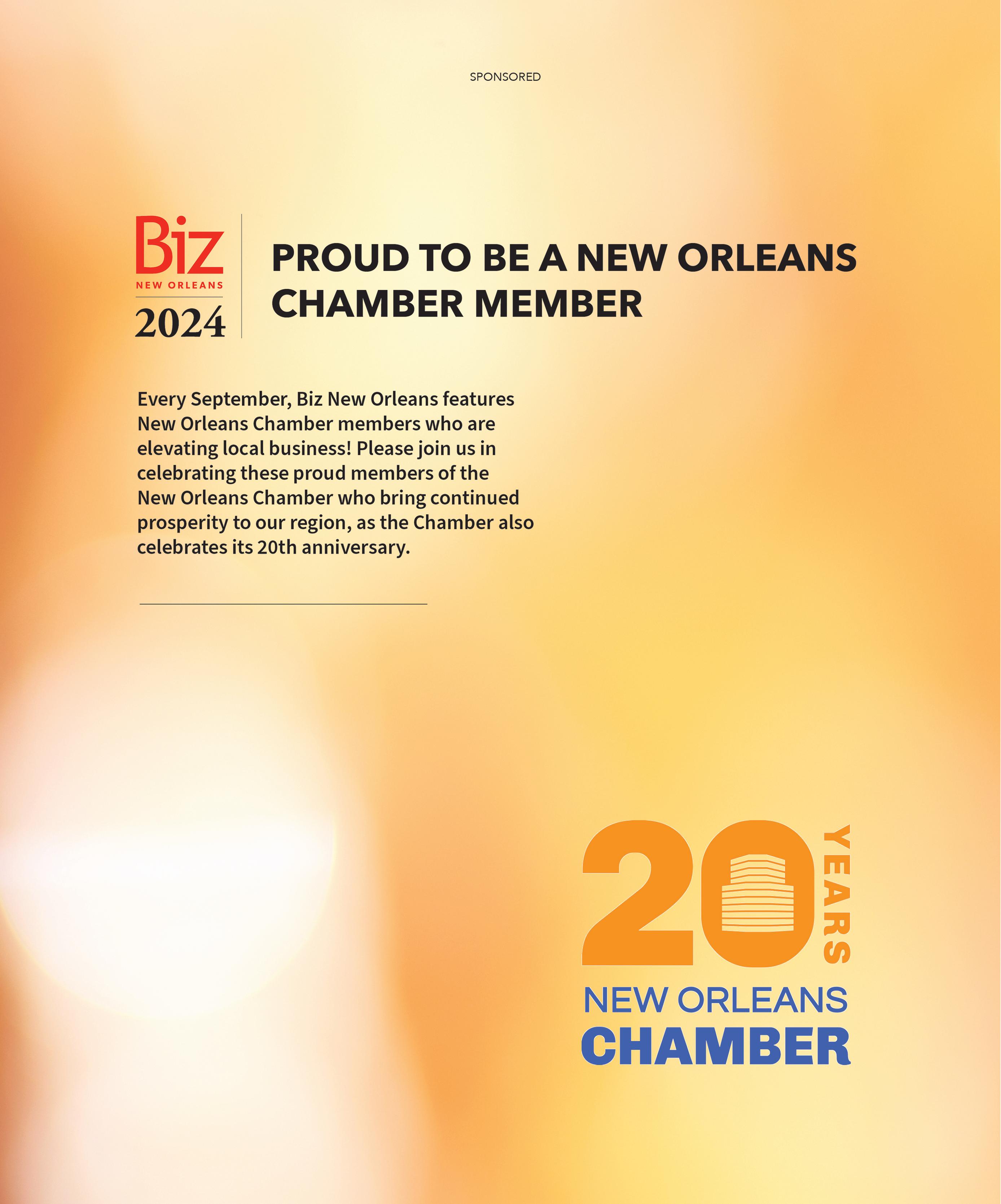

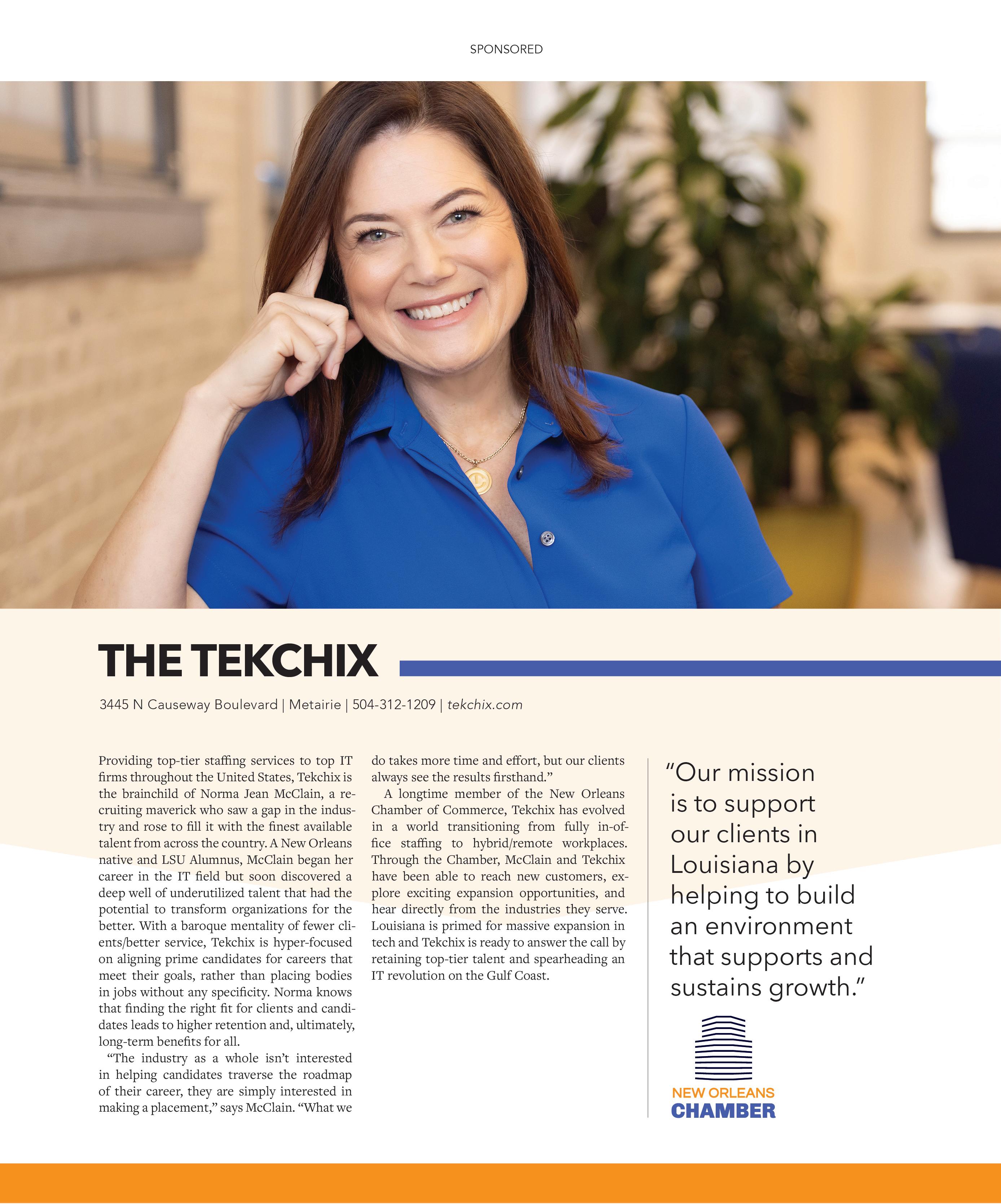
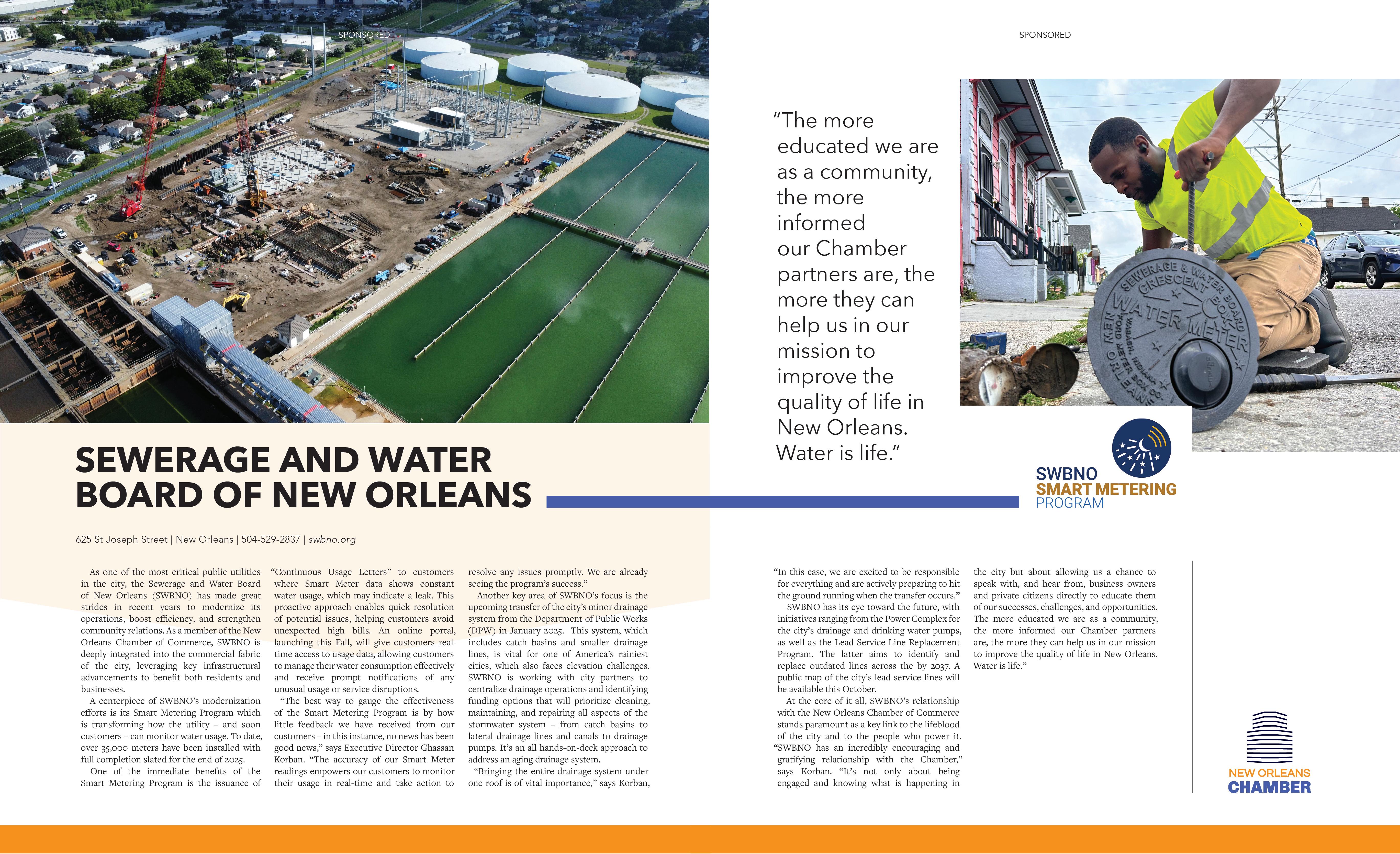

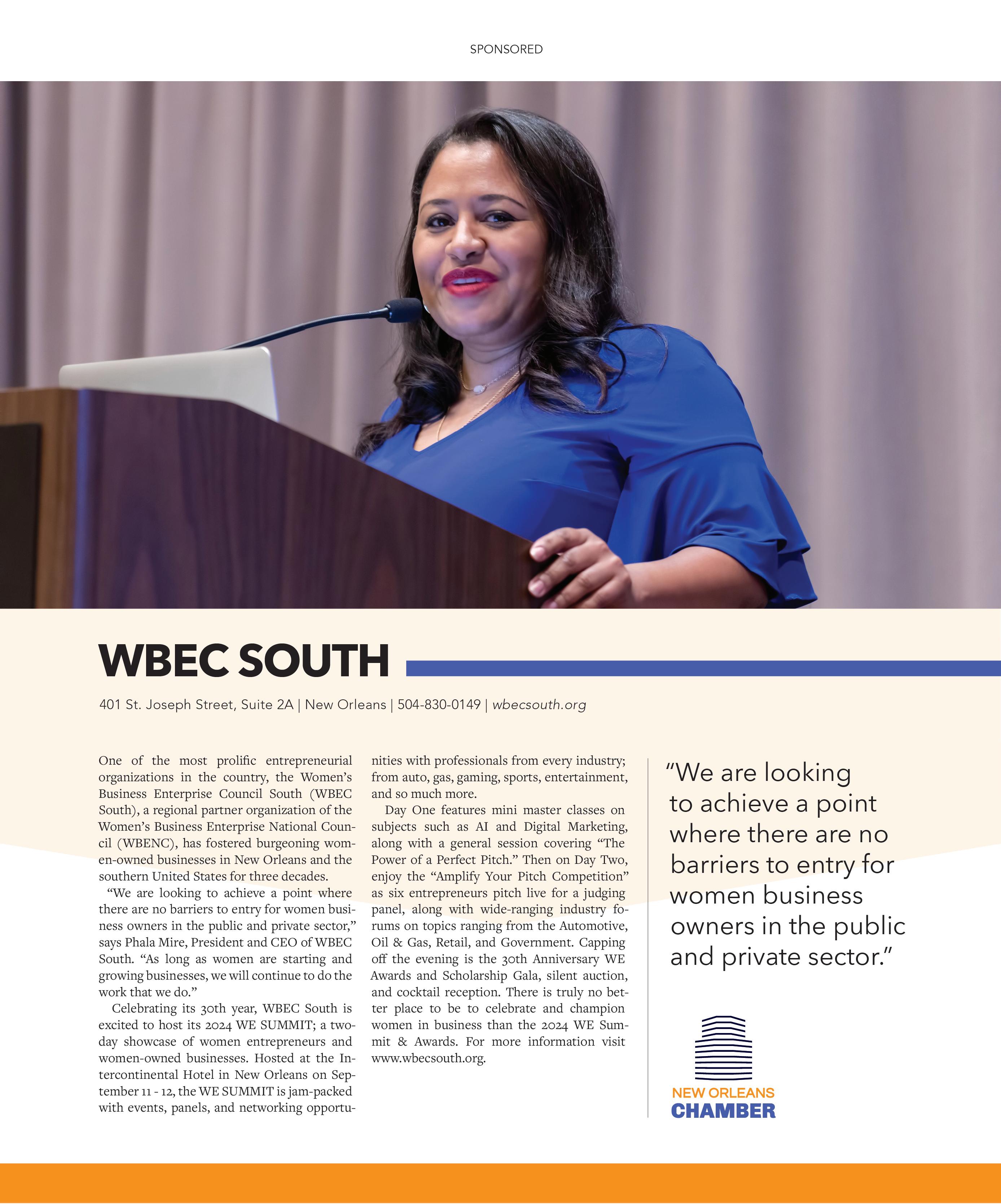
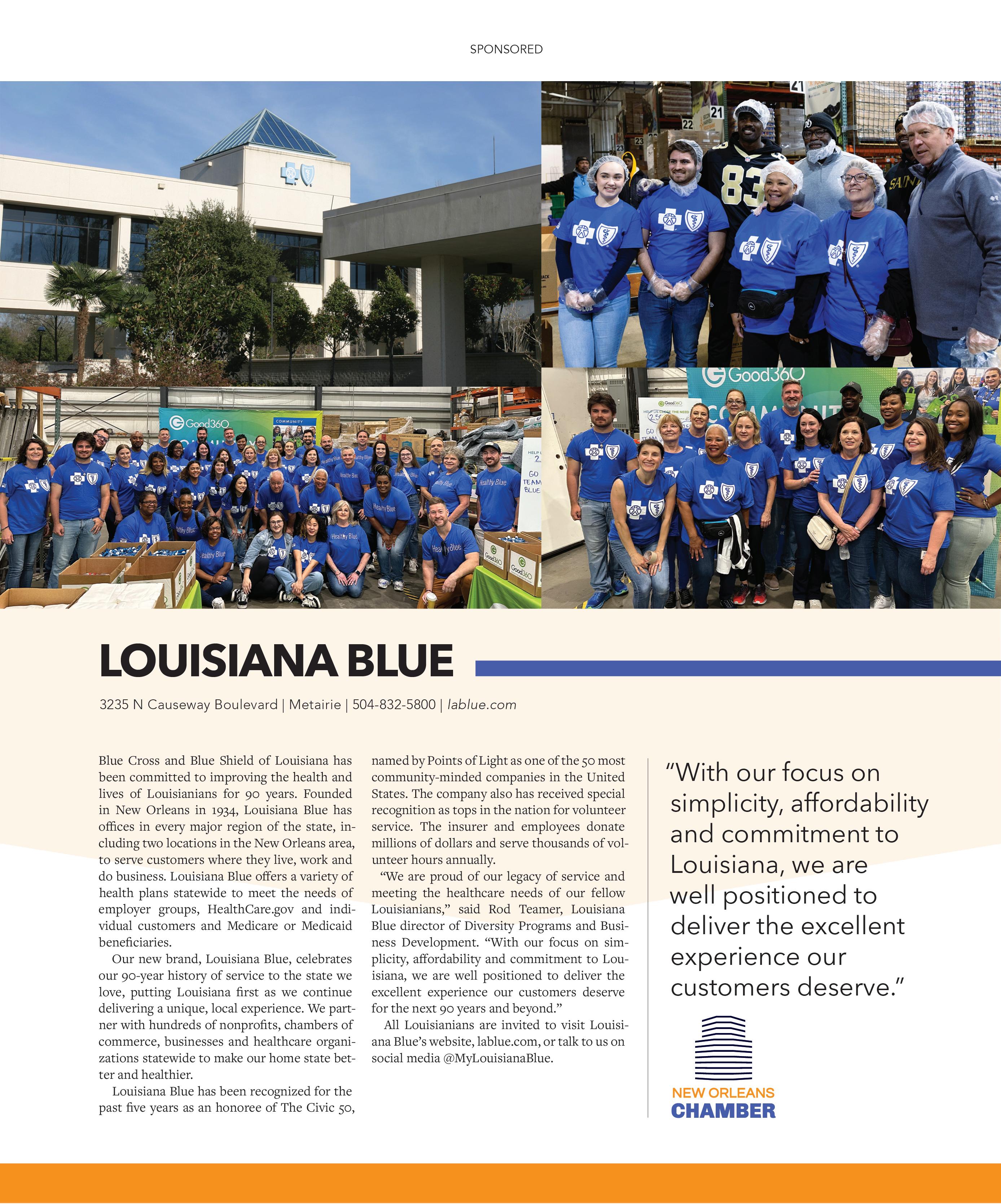

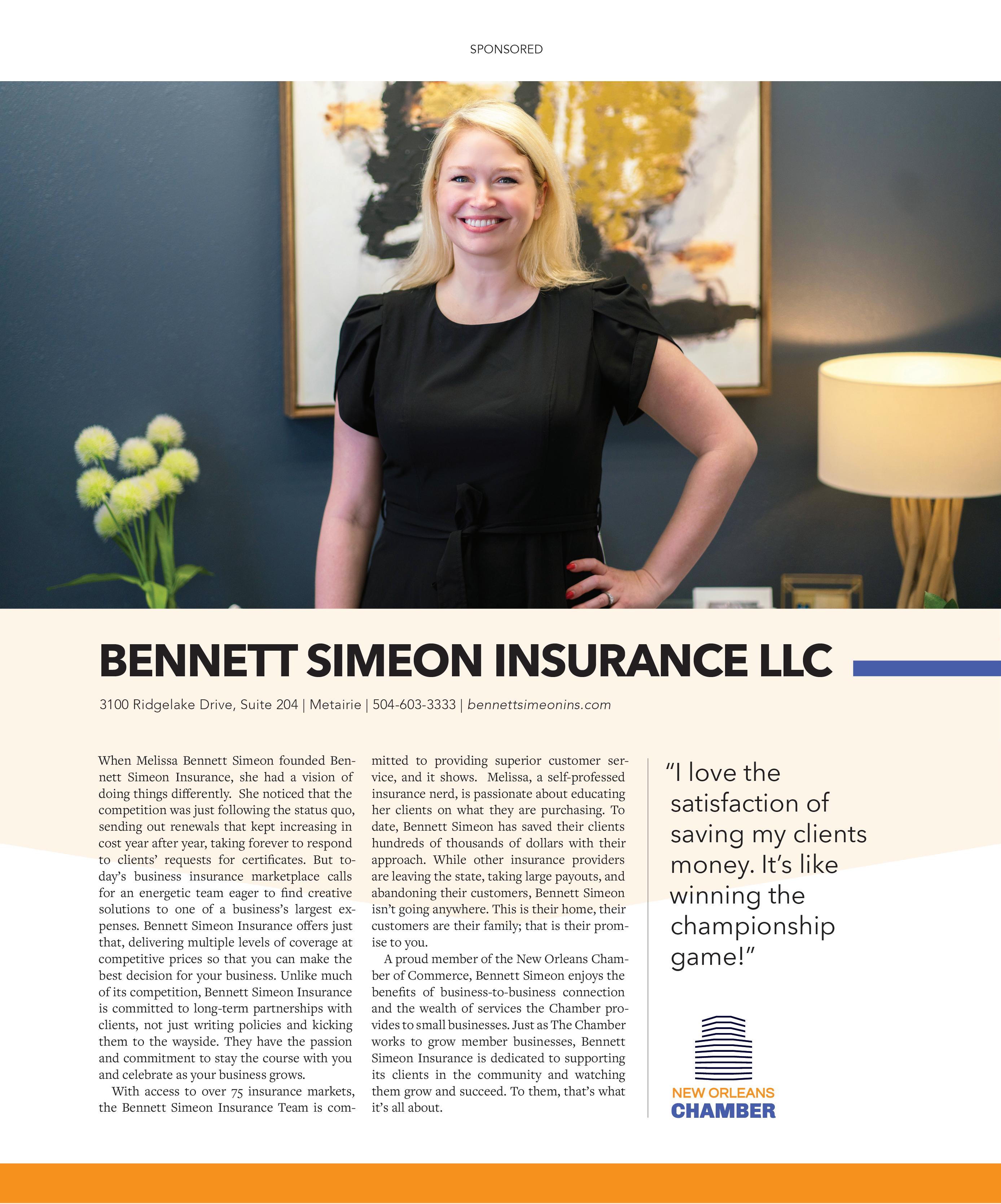
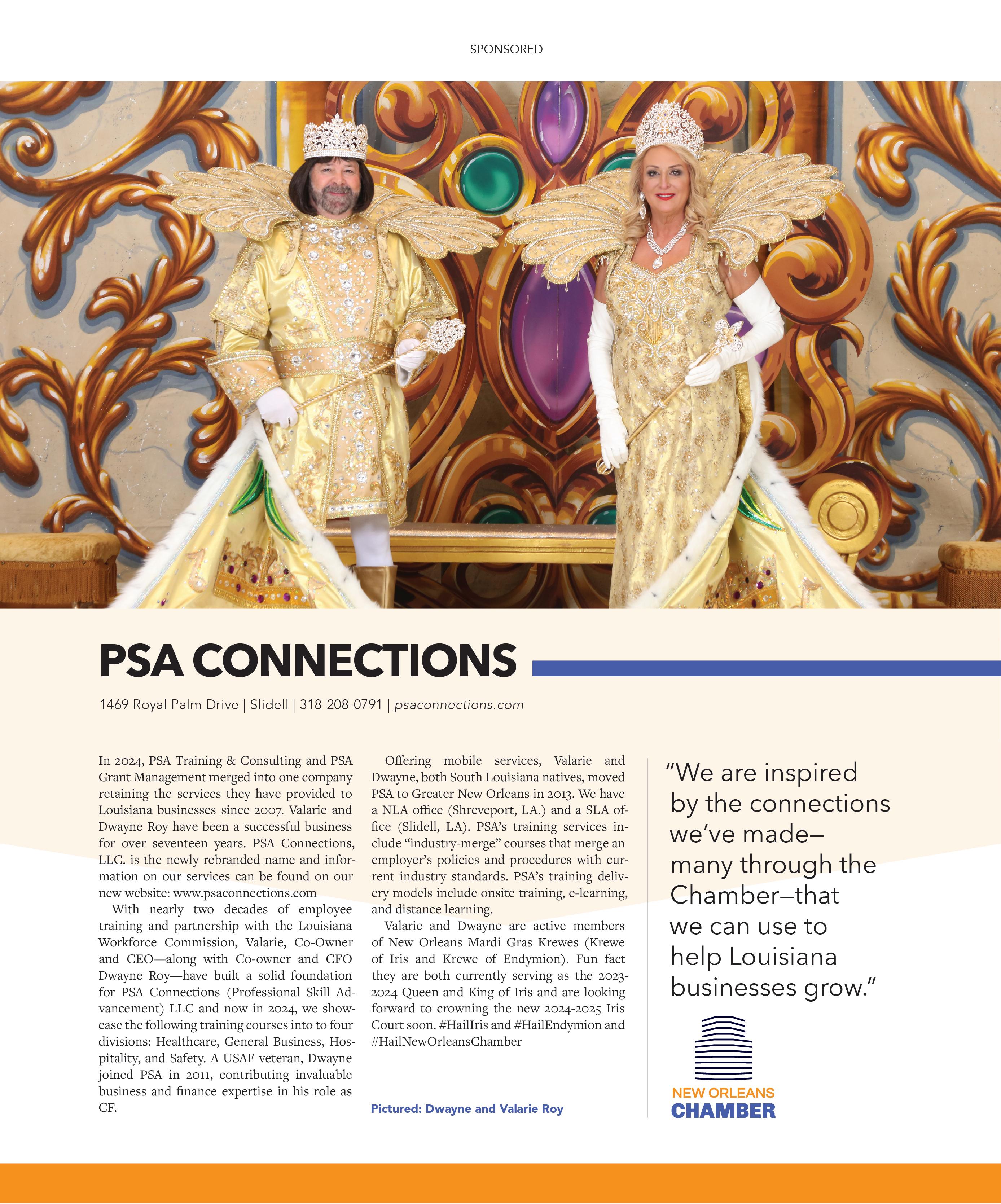


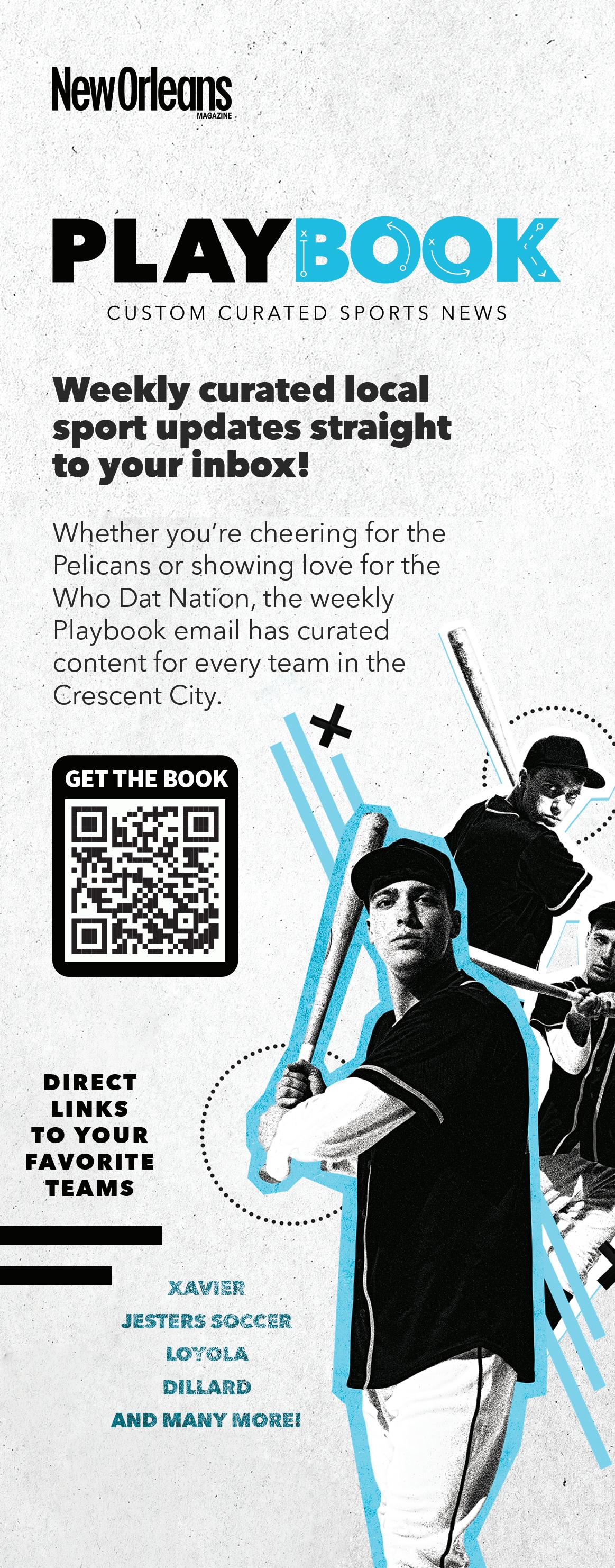

58 WHY DIDN’T I THINK OF THAT?
A new venture is bringing women together in creative ways that are proving personally and professionally beneficial
62
NEIGHBORHOOD GEM
Although only five years old, this Marigny garden supply store has quickly taken root
64
NEW ORLEANS 500
Mark Romig, chief marketing officer/senior vice president of New Orleans & Company and honorary consul for the Kingdom of Thailand
After more than three decades serving as home to the Louisiana Children’s Museum, 420 Julia Street is now home to a different kind of social gathering space
After more than three decades serving as home to the Louisiana Children’s Museum, 420 Julia Street is now home to a different kind of social gathering space
BY MISTY MILIOTO PHOTOS BY LAURA STEFFAN
The greatest ideas can come about in the unlikeliest of ways.
In the case of a creative business venture called Common House, it all started with the game of bridge.
While helping to produce a documentary about the card game, Charlottesville, Virginia native Derek Sieg realized there was a decline in organizations — such as bridge clubs, neighborhood associations and bowling leagues — that bring people together.
Longing for social clubs like those he experienced in Los Angeles, Sieg teamed up with Ben Pfinsgraff to co-found a common space that would attract like-minded individuals over food, drink and shared experiences. And thus, Common House was born.
The duo opened the first Common House in Charlottesville, Virginia, in 2017, followed by locations in Richmond, Virginia, in 2020, and Chattanooga, Tennessee, in 2021. The fourth Common House location opened in New Orleans’ Warehouse District in June. The modern social club aims to create connection among members through curated programming, thoughtful design and intentionally sourced food and beverage.
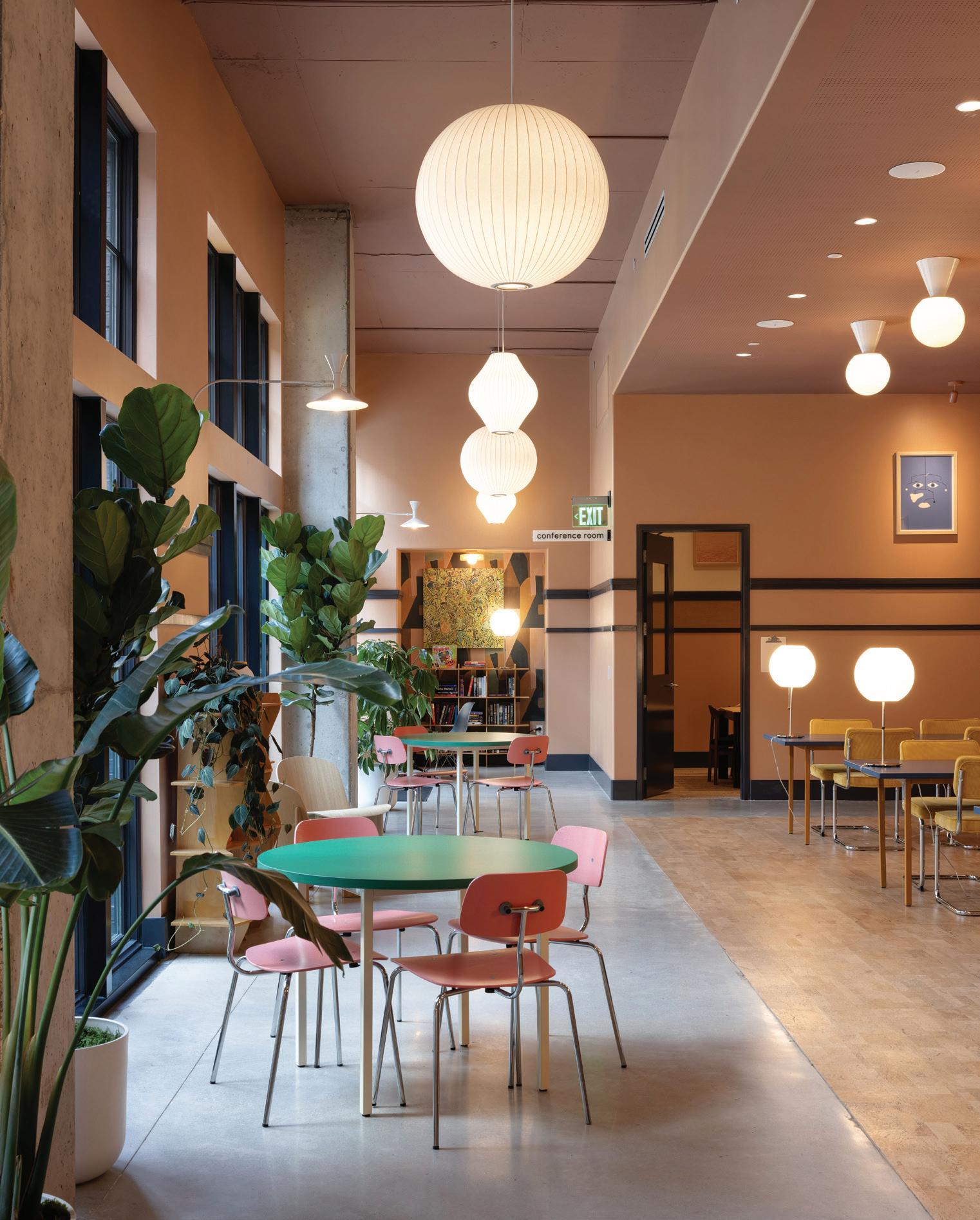
AJ Capital Partners, the owner and developer of the property — 420 Julia Street, which formerly housed the Louisiana Children’s Museum — retained Hartshorne Plunkard Architecture (HPA) to design its adaptive reuse into a mixed-use development.
“When Common House expressed interest in the site, we began test fits with the AJ Capital team to explore how their desired program could work within the existing building,” said
Stephen Marcus, principal at HPA.
The team at HPA — which also included Aracely Nevarez as partner-in-charge, Paul Alessandro as project partner, Stephen Marcus as project architect and Aileena Gray as designer — handled the architectural design for the renovation of the 46,000-square-foot historic building, as well as the interior architecture and a fivestory 117,000-square-foot addition. Common House now occupies nearly 20,000 square feet

Number of years in operation
The first Common House opened in 2017 in Charlottesville, Virginia. Common House New Orleans opened in 2024.
Style of architecture
Historic renovation
Square footage
Nearly 20,000
Number of Employees
45
Persons in Charge
Sarah Haviland, director of operations; Nick Karel, general manager
Architecture
Hartshorne Plunkard
Architecture
Interior Décor
Joshua Charles of Joshua Joseph Interiors
Interior spaces at Common House are flooded with light and overlook a communal courtyard.
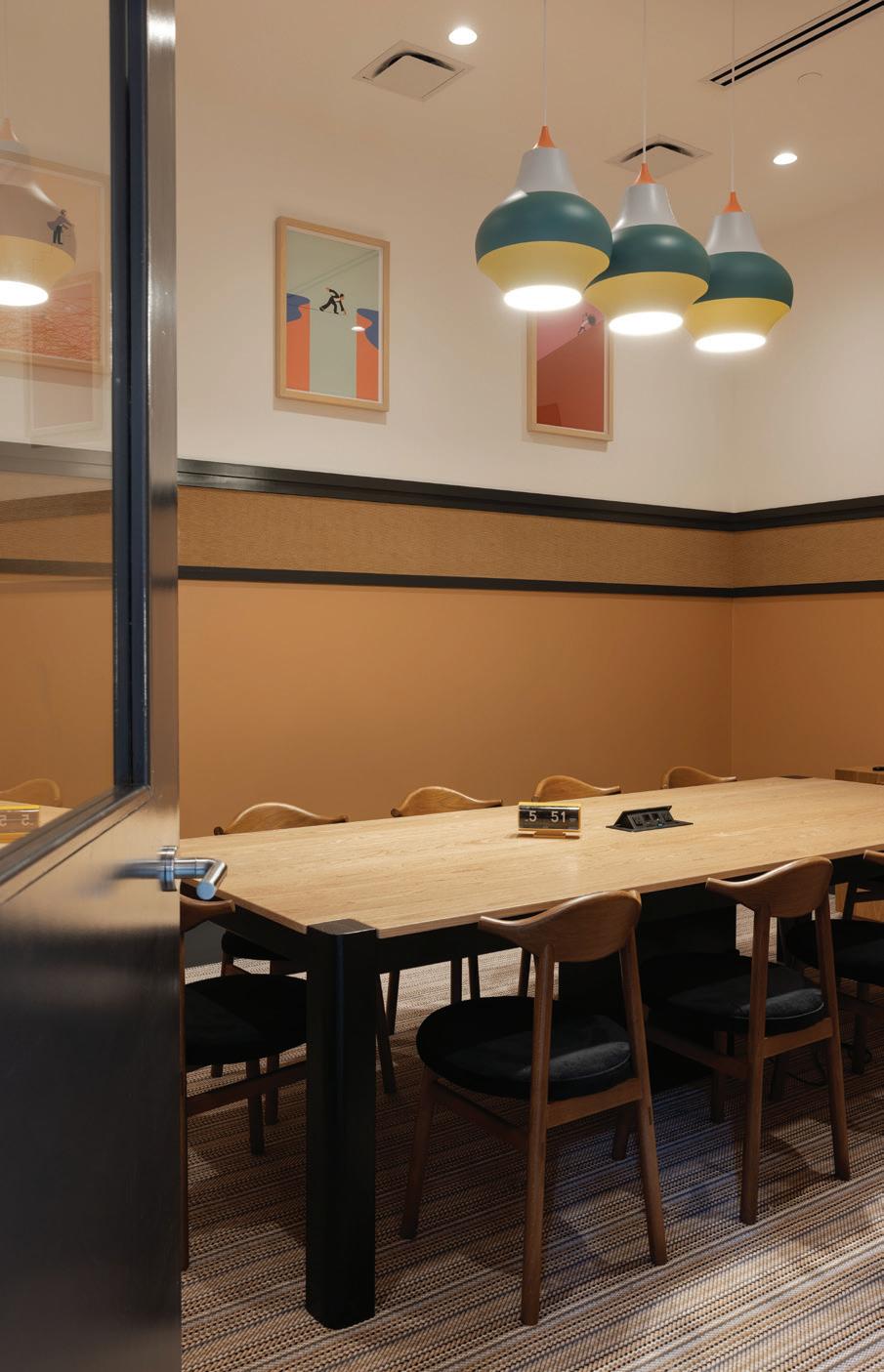
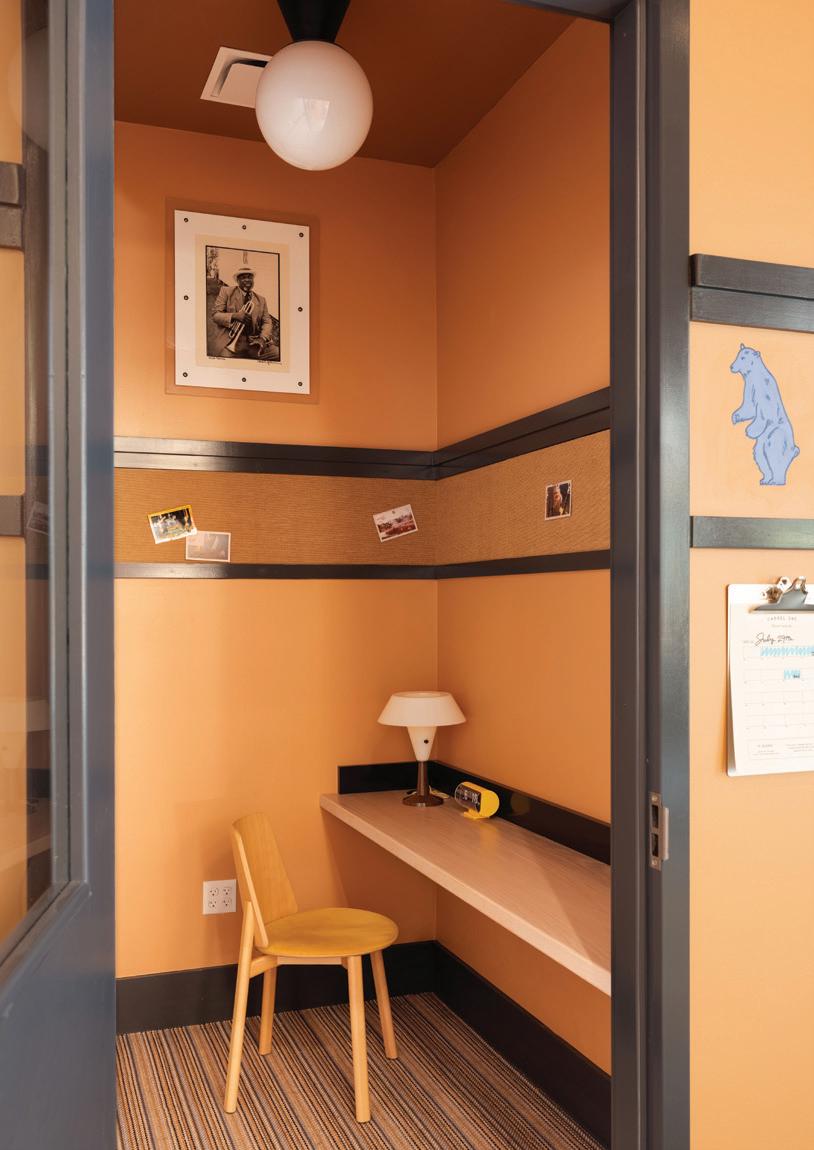
Common House includes a restaurant and bar, two event spaces, a social hall, open co-working spaces, private offices, conference rooms and more. Playful elements, such as hand-painted murals, harken back to the building’s former use.
on the first floor of the building, while Memoir Warehouse District, a multifamily property owned by AJ Capital Partners, operates 43 hotel rooms on the second floor and 70 apartments on floors three through five.
When the Louisiana Children’s Museum occupied the building, it had three levels, including a mezzanine. To provide Common House with more open, taller spaces, the architectural team removed the mezzanine level.
Common House now includes a restaurant and bar (helmed by Chef de Cuisine, Sean Rajo), two event spaces, a social hall, open co-working spaces, private offices, conference rooms, phone booths, and support spaces like storage and administrative offices. Amenity areas include the fitness center and locker rooms on the second floor, and the rooftop pool deck.
“The critical, driving factor for Common House is how they interact with their guests,” Marcus said. “To ensure efficient food and beverage operations, the kitchen had to be centrally located with multiple routes in and
out to directly connect to both event spaces, the dining hall and the bar. This element became the heart of the program around which all other rooms were subsequently organized.”
Meanwhile, the presence of columns caused interruption to the desired program.
“Working closely with our structural team to eliminate columns, brace existing ones and cantilever loads, we were able to carve out large spaces for events,” Marcus said. Several timber columns remain.
The museum’s old blue exterior double doors are still in place, and the same hue is translated into the interior via plaster, tiles and painted surfaces. The interior’s exposed brick and concrete floors were also preserved.
The historic building and new addition now come together to carve out a long inner courtyard, which allows daylight to penetrate the heart of the deep site.
“It is a special moment to stand in the negative space and take in the dialogue between these new and old elements,” Marcus said. The team also used reflective materials, glossy tiles and glass block to create brighter surfaces and channel light into some of the deeper spaces.
Joshua Charles, owner of Joshua Joseph Interiors, began the interior design work in early 2023 with two main goals: to design Common
House in a way that reflected New Orleans (while still feeling uniquely like a Common House) and to be respectful of the existing space.
“We spoke with people in the community who had emotional experiences with the Children’s Museum, and it became clear that the house needed to honor those moments and to be playful,” he said. “We mixed textures, colors, patterns and tile, and we had murals commissioned from local artists such as Brandan ‘BMike’ Odums and Tyrell Shaw.”
Charles also found inspiration in one of his favorite books from childhood, “Where The Wild Things Are.”
“There is a quote in the book we have written on the wall outside the green room, a space meant for special occasions, that says, ‘There should be a place where only the things you want to happen, happen,’” Charles said. “That stuck with me, and it became our motto.”
Charles used shades of terra-cotta in the workspaces; purples, blacks, pinks and yellows in the social hall (as a nod to Mardi Gras); and tone-on-tone greens in the green room.
“The dining room is where you can find every color we used in the whole space in varying forms,” he said. “They meet here as one and break apart as you explore each nook and cranny.”
As Common House continues to expand to midsize cities throughout the country, the fifth location is currently being designed in Memphis. T
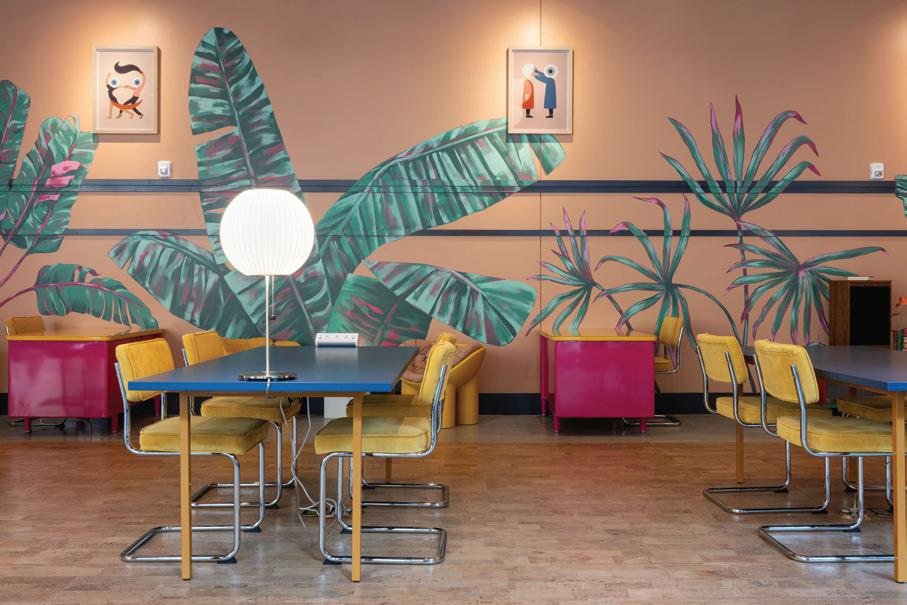
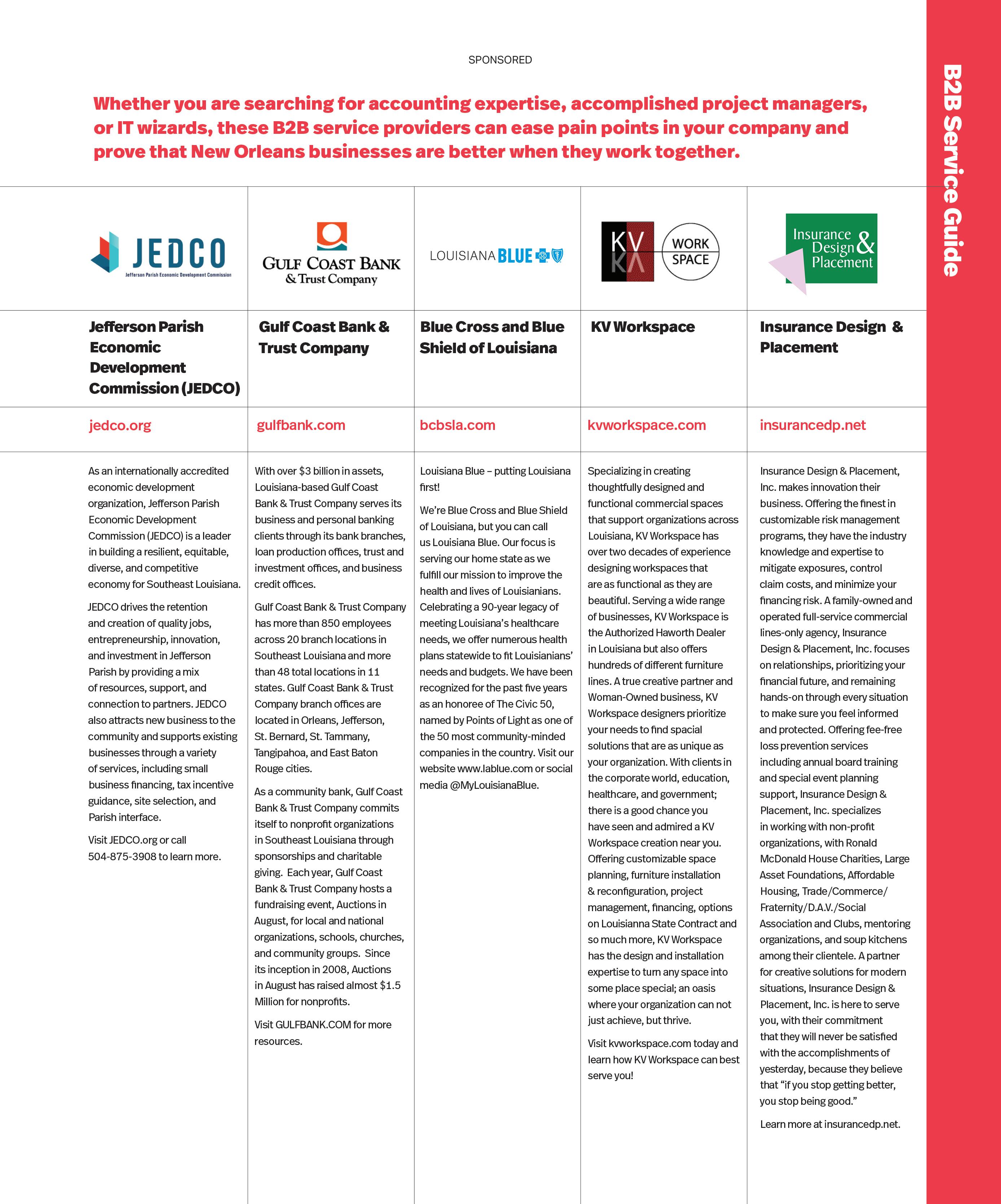

A new venture is bringing women together in creative ways that are proving personally and professionally beneficial
BY ASHLEY MCLELLAN
PHOTOS BY EDMUND D. FOUNTAIN
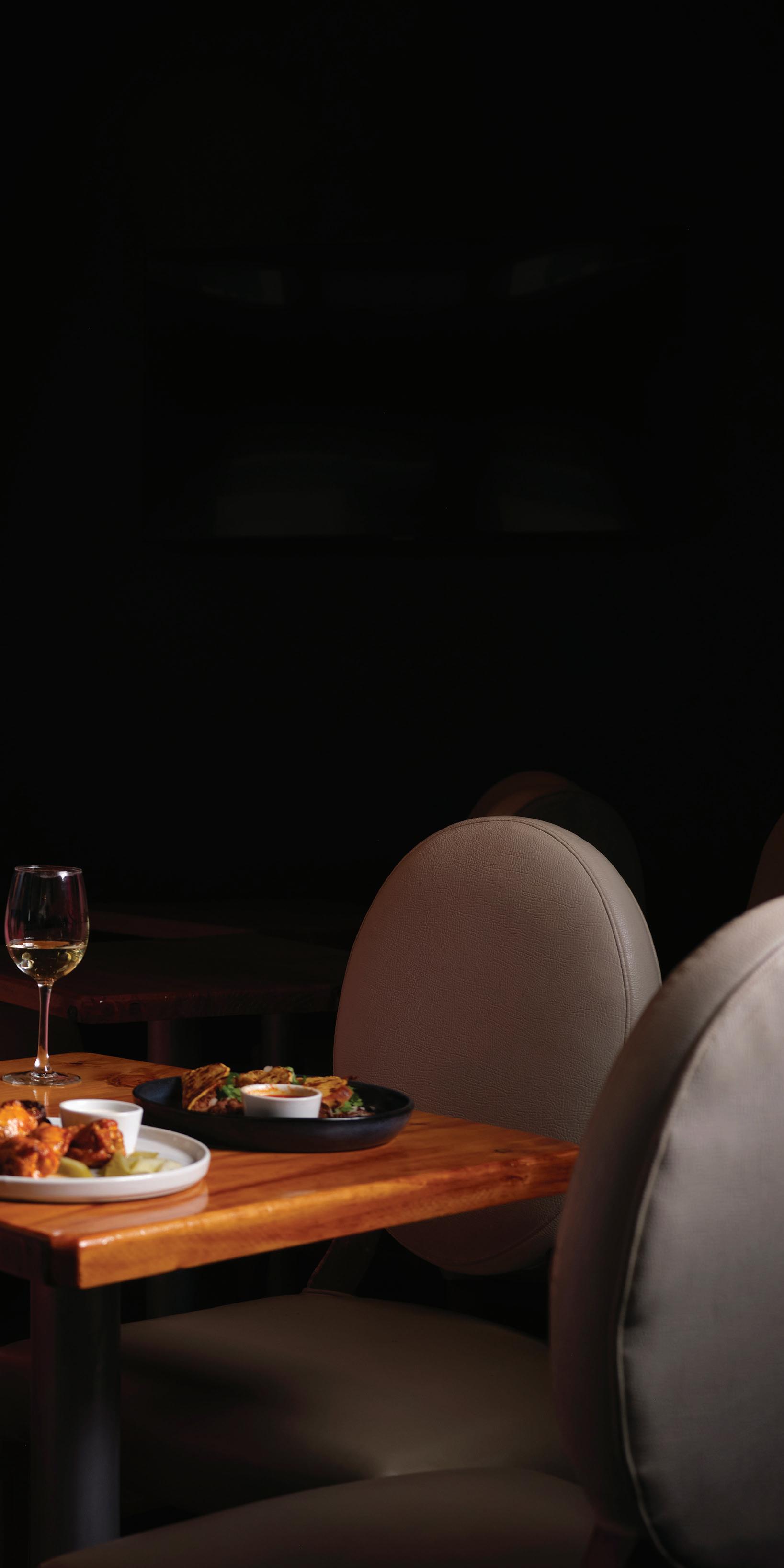
American cultural and fashion icon Gloria Vanderbilt once said, “I always believed that one woman’s success can only help another woman’s success.”
One local networking startup is taking that idea and bringing it to life by hosting various events around the city.
Laura Walter — a Baton Rouge transplant post-college — and New Orleans native Caitlin Minshew founded The New Orleans Girls Club in December 2023 and officially launched a month later. The goal was to create a space for women across the city to gather, exchange ideas and support one another.
“Many women in the city, including myself, work remote jobs or have a hard time finding ways to make new friends,” said Walter. “The New Orleans Girls Club brings together women across different age groups and provides the opportunity for support, connection and mentorship in New Orleans.”
The network hosts a variety of social events each month around the city — both free and ticketed. A recent calendar lineup included a $35 networking event with wine and light bites, a champagne and Botox party, and a casual pool party at the Royal Sonesta.
Social media connection played a big part in not only the formation of the original idea (the co-founders met via Instagram), but it also continues to impact how the company reaches new members.
“We have only used social media and word of mouth to market our events and brand,” said Walter. “It has helped us bring so many women together.”
The response to events has been both positive and informative for organizers, local busi -
nesses and attendees. The club has partnered with hotels including the Hyatt, Royal Sonesta and Virgin Hotel New Orleans, boutiques such as Hemline and Krewe Eyewear, fitness centers, restaurants, and our sister publication New Orleans Magazine.
The events offer local businesses increased exposure to a new audience while providing a forum for eventgoers and The New Orleans Girls Club, which typically charges a percentage of ticket sales for collaborative events.
“My favorite event was our cooking class at New Orleans School of Cooking,” said Minshew. “It was a smaller and more intimate event, which allowed us to get to chat more one-on-one with the women who attended.”
While events are structured around entertainment, it’s not all just fun and games for Walter and Minshew. The two are serious about making sure meaningful connections are made for lasting relationships among participants.
“Our goal is for women to build connections and grow their circle of supportive and likeminded women,” said Minshew. “We hope that women can build upon their support system and feel encouraged and empowered to accomplish their biggest goals.”
Among those goals could be receiving better wages, which Minshew noted could be aided by women creating connections and sharing wage and work information. She also added that the club’s newly launched Facebook group aims to create a hub for women to connect and share resources — such as finding roommates and job opportunities — in a safe, online environment.
Beyond its calendar of monthly events, The New Orleans Girls Club’s own agenda is already packed for the next few months. The club has released an exclusive digital “how to” guide for those looking to launch a networking club in other cities, and a “Pink Dress Crawl” in the French Quarter is on the books for this October. The fundraising event will benefit the National Breast Cancer Awareness Foundation.
Looking to the future, Walter and Minshew said they are planning an expansion of the club basic model, with new levels and programs that will allow women to network in a new way while continuing to collaborate with businesses across the city.
“The [Girls Club] is launching an official membership program at the end of 2024,” said Walter, “where members will be better able to connect, have access to volunteer opportunities, get special perks and discounts at our favorite New Orleans businesses, and more.” T
Founders Walter and Minshew rely on the power of social media and connections made through events to reach potential members and partnership opportunities. A new membership program and the inaugural “Pink Dress Crawl” are in the works for this fall.
According to a recent survey of 751 women at and above management level in the U.S.: 80%+ report using networking to advance their careers.
The women reported using networking to aid them in:
Joining a board — 90%
Breaking into the C-suite — 84%
Taking a new job with better pay — 81%
Winning new business — 85%
Implementing new frameworks or models — 84%
Source: Survey reported in July 2023 by Chief.com in collaboration with Morning Consult


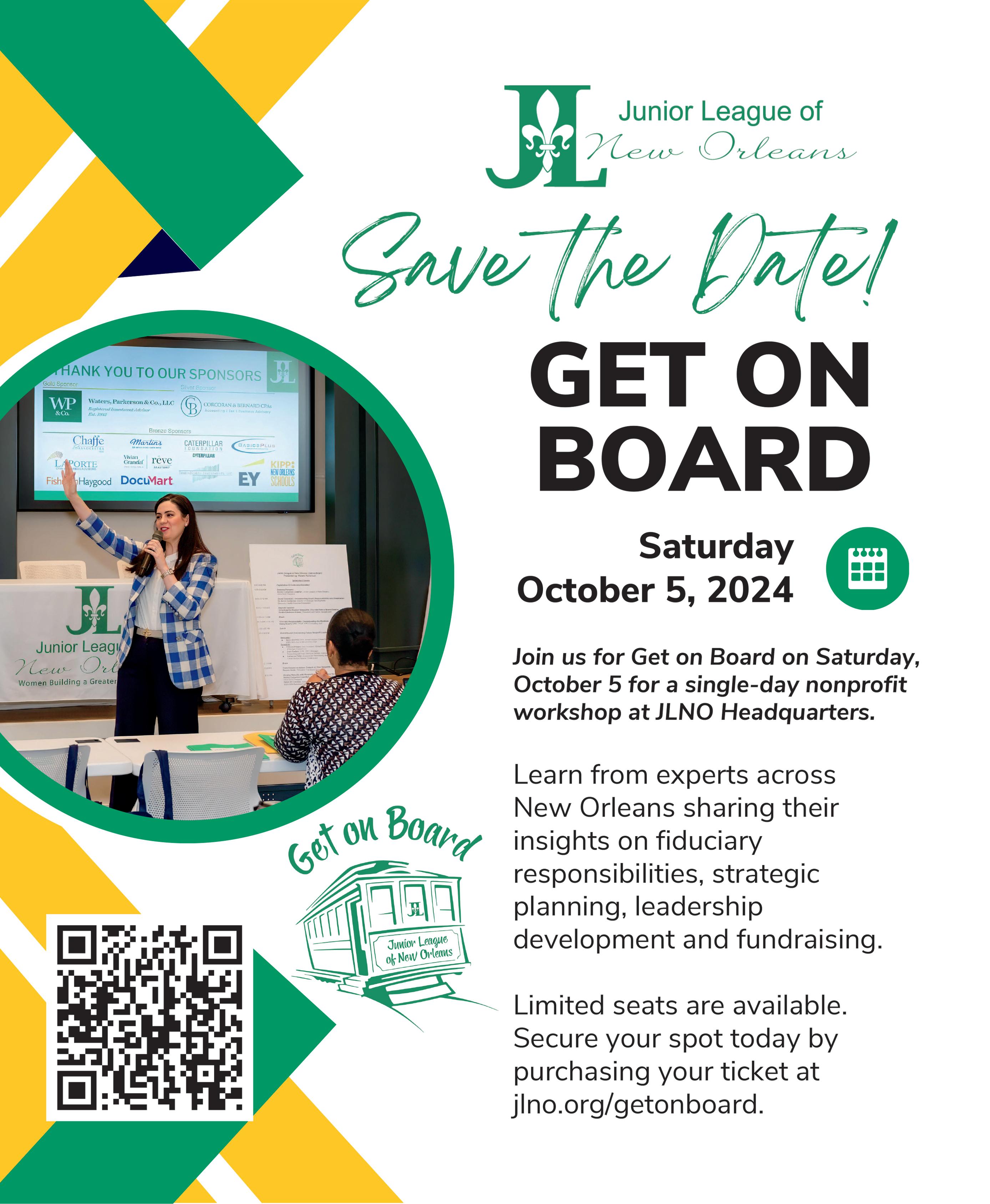
Although only five years old, this Marigny garden supply store has quickly taken root
BY KEITH TWITCHELL
For a store focused on indoor and small-space gardening, Grow Wiser Garden Supply’s location at 2019 Decatur Street at the tip of the Marigny is ideal. Nearby Marigny and French Quarter residents — whose apartments often come include courtyards — provide a regular stream of local business.
As the only store in the state specializing in hydroponic growing (growing plants in water rather than soil), Grow Wiser also attracts customers from throughout the surrounding region, even as far as Mississippi, and has commercial and retail accounts all over the country via its website.
Owner Scott Edwards abandoned his previous work as a photographer to buy out a store called Urban Organics in 2016, opening up the present operation about six months later.
“Hydroponic gardening is becoming more popular every year,” Edwards reported. “There was a huge uptick during the pandemic; prices went sky high. Now the prices have settled down, but the popularity is still there.”
Edwards sees a similar trend in regular houseplants and Grow Wiser has plenty of
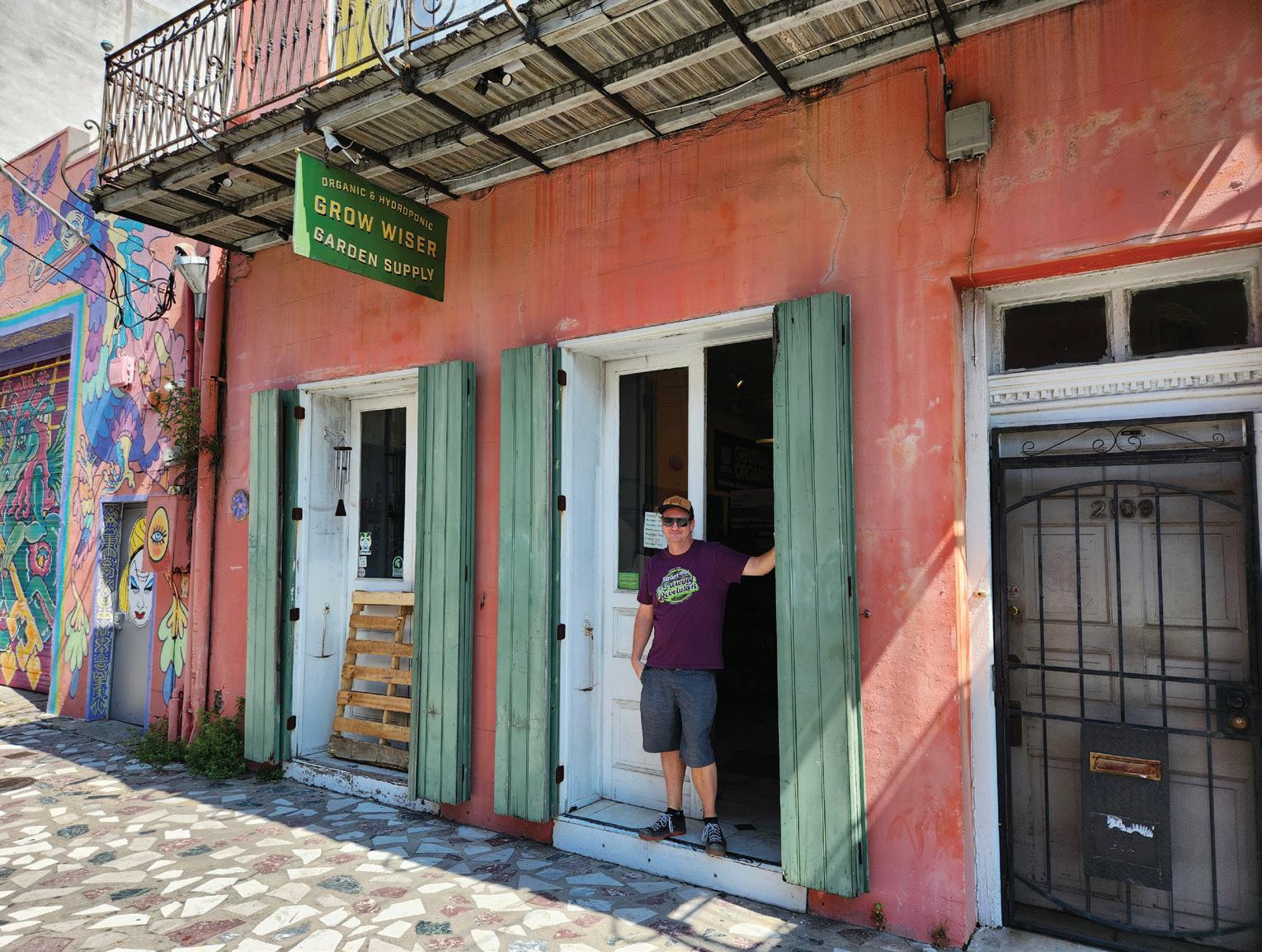
supplies for both approaches. This includes hydroponic plant nutrition and organic nutrition; all kinds of lighting and equipment for indoor growing; and the pumps, containers and other equipment particular to hydroponics. The store also offers pest and mold control supplies, soils, and even garden pond supplies.
One thing Grow Wiser doesn’t offer, however, is plants. They require a separate license.
While the products alone set Grow Wiser apart from regular garden supply stores, Edwards’ enthusiasm for, and expertise in these specialized growing methods is what really makes a difference.
“You can come in here pretty cold [about hydroponics], and I will talk your ear off about it,” he said. “It’s free with purchase! But I really want people to be successful with growing indoors.”
Edwards emphasized that growing hydroponically is not particularly difficult.
“There are not tons of things you have to worry about,” he noted, “but the things that do need to be done need to be done properly.”
Why grow plants in water?
“The most fun part about hydroponics is the results! You can get higher yields and faster growth rates than with traditional methods.”
Among the types of plants often grown hydroponically are various ornamentals, including orchids; herbs and vegetables, especially leafy ones; and, where legal, cannabis. The last item creates a delicate situation for Edwards, who has many customers in states where growing marijuana has been legalized. He is, however, prohibited from discussing the topic with locals.
Walking this fine line is one challenge Edwards faces; another is managing the marketing, since his is a one-man operation. Having had little success with traditional advertising approaches, he mostly relies on Google Shopping ads, along with Facebook and Instagram ads and posts.
“Maintaining that online presence is a big challenge,” he said. “The online marketplace has a lot of competition, and I must keep the products and pricing updated constantly on the website. Running the store day-to-day, dealing with the customers are what I like best.”T
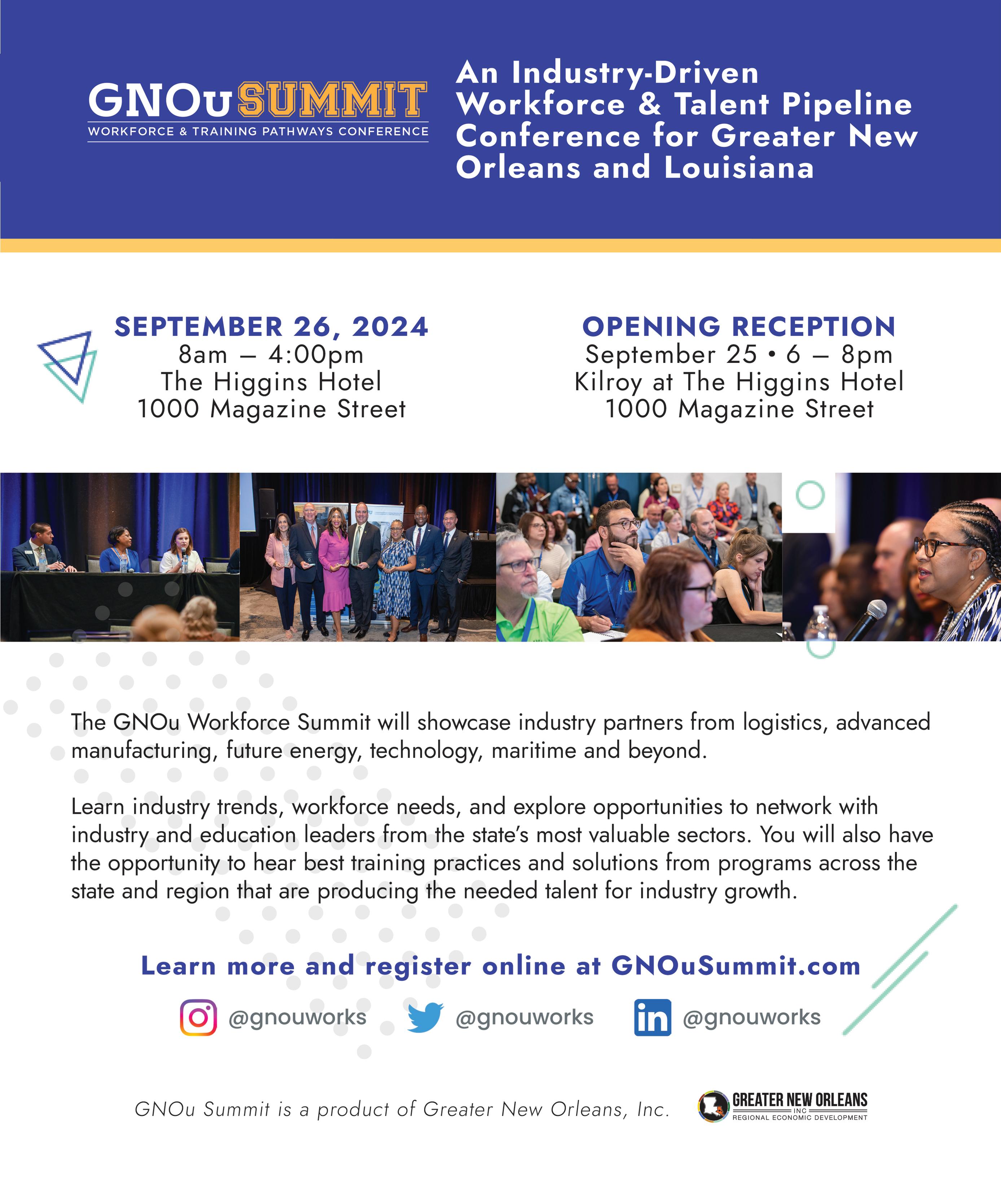
EDUCATION University of New Orleans (BS)
ADVICE Mentor others as often as you get the chance.

The Rib Room at the Omni Royal Orleans during the holidays. Also the Clock and Watch Shop on Gravier Street.
chief marketing officer/ senior vice president of New Orleans & Company and honorary consul for the Kingdom of Thailand
BY MIKE LIRETTE
HOBBY Reading as many newspapers as I can
Over the last 44 years, Romig has worked on presidential campaigns, served as protocol and guest relations for the 1984 Louisiana World’s Fair and organized the New Orleans Tricentennial 300th anniversary celebration. He is the stadium announcer for the New Orleans Saints and the recipient of lifetime achievement awards from New Orleans Wine & Food Experience and the local chapter of the Public Relations Society of America. Romig is also the current chair of Fore!Kids Foundation and WYES-TV and serves on the board for Fidelity Bank and on the Super Bowl LIX Host Committee as co-chair of the Media/PR/Branding subcommittee. T
